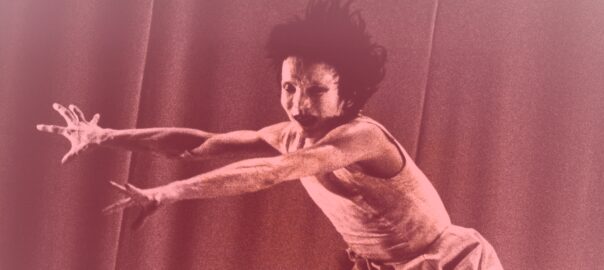“My Road” from debut as a Butoh dancer to conception of “SPACE DANCE & DESIGN MUSEUM”. There were many “Unexpected Encounters“.
舞踏家としてのデビューから、『スペースダンス&デザインミュージアム』の構想に至るまでの「私の道」。多くの「思いがけない出会い」があった。
…………………………………
[2024]
[My Road / 私の道 <75>]
“SD2 GALLERY / Space Dance & Space Design GALLERY”
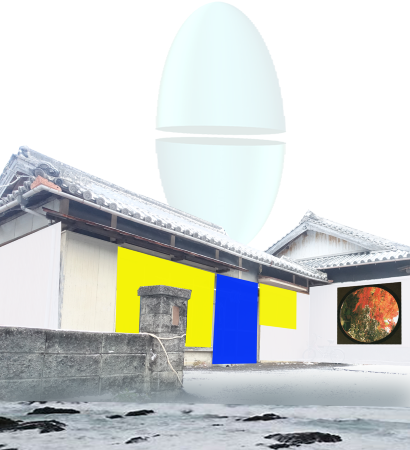
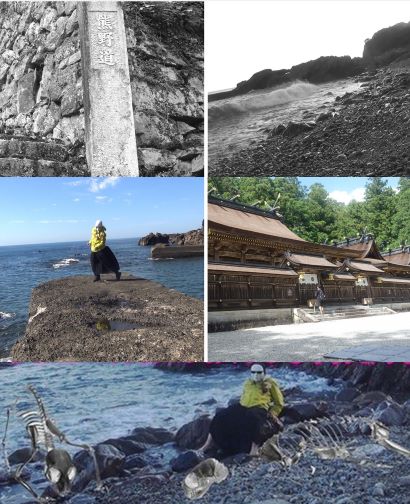
I will start SD2 GALLEY on 2024 June 7 to open “SPACE DANCE & DESIGN MUSEM”. The museum opening members come together in this studio, get the budget, design the museum, and create all contents that compose the museum.
『スペースダンス&デザインミュージアム』を開館する為に、SD2 GALLERYを2024年6月7日よりスタートする。このスタジオに、ミュージアム開館メンバーが集い、予算を獲得し、ミュージアムを設計し、ミュージアムを構成する全コンテンツを制作する。
…………………………………
[2023]
[My Road / 私の道 <74>]
“New Challenge & New Vision / 新しい挑戦・新しい展望”
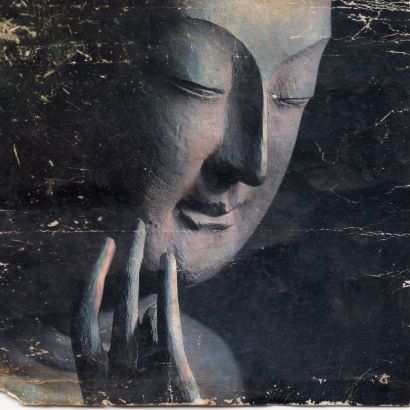
My work is to complete the development of “Aparos & Design” based on the “Body-Space Model” and to realize various designs using it. And, with its results, it is to open and operate SPACE DANCE & DESIGN MUSEUM with my members.
私の仕事は、「身体-空間モデル」をベースにした「アパロス & デザイン」の開発をメンバーと共に完成させ、それを使用した諸々のデザインを実現する事。そして、その成果をもってスペースダンス&デザインミュージアムを開館し運営する事。
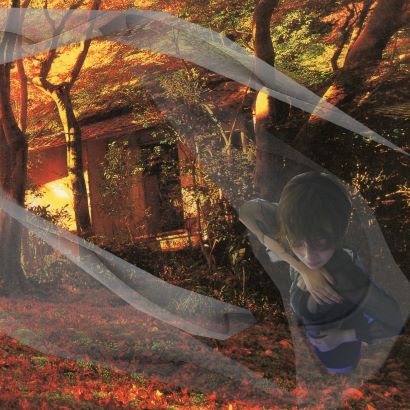
Personally, I will start full-scale writer’s activity and create Elena who lives in surplus dimensions as an avatar and make her appear in my life, and call real Elena through this avatar, then start “New Life with Elena & Big Family“. Just now, I am preparing it. I have enough time for this work.
個人としては、作家活動を本格化し、余剰次元に住むエレナをアバターとして創造して生活の中に登場させ、このアバターにより現実のエレナを呼び寄せ、「エレナ&大家族による<新しい生活>」を始める事。ただ今、準備中。時間は充分にある。
…………………………………
[2022]
[My Road / 私の道 <73>]
“With Multiple Lives / 複数の人生を”
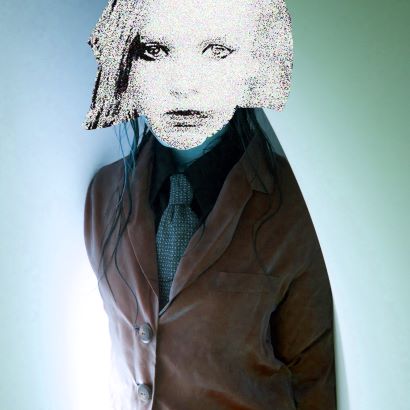
Jacques Attali, a philosopher who pushed Macron to become president of France said that “in order to live a meaningful life from now, we need to live multiple lives simultaneously and continuously.” I live with the same feeling. It is not a recommendation for division, but a guideline for living in the most luxurious world of the present age when the average life expectancy is 120 years old. Instead of choosing some of our possibilities and giving up on others, realize all of our possibilities. It’s unreasonable, so it deserves the name “Challenge.“
マクロンをフランスの大統領に押し上げた哲学者ジャック・アタリは、「これからの人生を有意義に生きるためには、複数の人生を、同時かつ継続的に送る必要がある」と言っている。私も同じ思いで生きている。それは分裂の勧めではなく、やがて平均寿命が120才になる現代という世界を最高に贅沢に生きる為の指針である。自分の幾つかの可能性を選択して他を諦めるのではなく、全ての可能性を実現していく事。通常、それはムリである。しかし、だからこそ「挑戦」の名に値する。
…………………………………
[2021]
[My Road / 私の道 <72>]
“Eckhart Garden / エックハルトの庭”
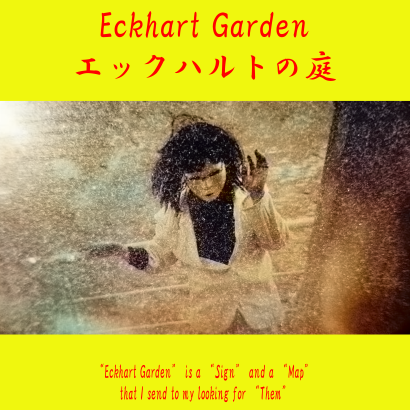
Meister Eckhart, a German medieval mystic and minister, was executed as a maverick, preaching that “God is created by humans. Without humans, God remains empty.” How radical this idea was in the Christian world at that time. I can imagine it enough. Two teachings learned from Eckhart. “We need to keep ourselves secret from any event, to anyone.” And, “If it works well, we need to forget it. If it fails, we need to behave as when it works well.”
マイスター・エックハルトはドイツ中世の神秘主義者・牧師で、「神をつくるのは人間です。人間が存在しなければ神は空っぽのままです」と説き、晩年に異端者として処刑された。この思想が当時のキリスト教世界でいかに過激だったか。それは充分に想像できる。私がエックハルトから学んだ2つの教え。「どんな事象に対しても、誰に対しても、内的に隠遁している必要があります」と、「うまく行った時はそれを忘れて。失敗してもうまく行った時と同じように振る舞うこと」。
With Eckhart as my “Teacher“, I named the new method of expression by an individual “A Sensual Jump“, and started the transmission of “Eckhart Garden” by integrating “poetry + design + space dance + story.“
私はエックハルトを「先生」として、個人による新しい表現の方法を「A感覚的跳躍」と名づけ、「詩 + デザイン + スペースダンス + 物語」の総合による「エックハルトの庭」の発信を開始した。
…………………………………
[2021]
[My Road / 私の道 <71>]
“Plan of SPACE DANCE & DESIGN MUSEUM
/ スペースダンス&デザインミュージアム計画”
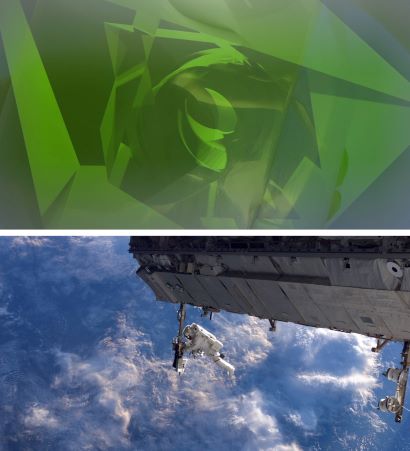
At SPACE DANCE & DESIGN MUSEUM, SPACE DANCE SCHOOL and SPACE DESIGN SCHOOL will operate as two wheels, and an educational project for children and a cultural development project for the elderly with the new ideas will be added. SPACE DANCE & DESIGN MUSEUM aims to find a new way of our life and is positioned as a “place for education necessary for humans to advance into space in the not too distant future.” I think the demand for this museum will increase more and more due to the development of the information society and the arrival of the space age.
スペースダンス&デザインミュージアムでは、スペースダンススクールとスペースデザインスクールが両輪として稼働し、そこに新しい発想による子供に対する教育事業と高齢者に対する文化開発事業が加わる。このミュージアムは、新しい生き方の開発を目的とし、「そう遠くない未来に、人間が宇宙進出を可能にする為に必要な教育の場」、という位置づけである。私は、情報社会の進展と宇宙時代の到来によりこのミュージアムに対する需要はどんどん高まると予想している。
…………………………………
[2020]
[My Road / 私の道 <70>]
“SPACE DESIGN SCHOOL / スペースデザインスクール”
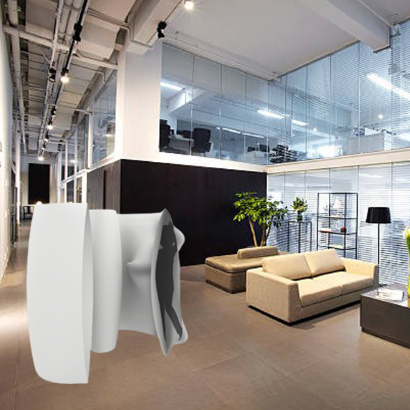
“SPACE DESIGN SCHOOL” takes on the role of the engine that operates SPACE DANCE & DESIGN MUSEUM together with the “SPACE DANCE SCHOOL.” This school realizes the important concept of Space Dance called “Dance and Design.” The students of this school will train the power of imagination and creation, and try to design several objects, spaces, and images for Space Dance.
スペースダンススクールと共に、スペースダンス&デザインミュージアムを推進するエンジンの役割を務めるスペースデザインスクール。「ダンス & デザイン」というスペースダンスの重要なコンセプトを実現する。ここに参加する生徒たちは、想像力と創造力を鍛え、様々な新しいモノ・空間・イメージのデザインに挑戦することになる。
…………………………………
[2019]
[My Road / 私の道 <69>]
“Sato by Aymumi Toyabe and SPACE DANCE SCHOOL
/ 鳥谷部歩美の「郷(Sato)」とスペースダンススクール”
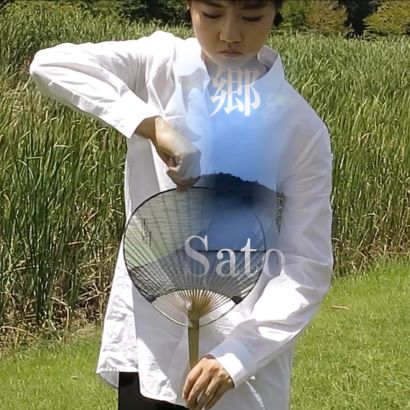

When I watched Ayumi Toyabe’s promotional video “Sato“, I was very surprised at the transparency that overflowed there. But I felt her presence special. Her transparency hinted at me “World of Tomorrow“, and through this encounter with her, I started “SPACE DANCE SCHOOL” with her as an assistant director.
鳥谷部歩美のプロモーションビデオ『郷(Sato)』を見た時、そこに溢れる透明感に驚いた。彼女のようなダンサーは世界中に沢山いるのかも知れない。しかし、私は彼女の存在を特別に感じた。彼女が持つ透明感が私に「明日の世界」を暗示する。彼女との出会いを通じ、彼女をアシスタントディレクターとして迎えて「SPACE DANCE SCHOOL」が始まった。
To grow a dance by becoming one with the space. And to develop artists who will be active throughout their lives without being influenced by the trends of the times. These two are the purposes of SPACE DANCE SCHOOL. There are many artists in the world. However, most of them are uneasy people who cannot be said to be active, always they care about people’s reputation, number of the audience, money, and never know when and who will let them go. The power of art is not that weak. Whether to continue or stop, it is important to be able to decide on our work at our own discretion. And since even one is enough, it is possible to create “New Fruit” that did not exist in history. That will be the proof of the artist.
空間と一体になることで自分のダンスを成長させる事。そして、時代の動向に左右されず、生涯にわたり能動的に活動するアーティストを育成する事。この二つがスペースダンススクールの目的である。世には多くのアーティストが存在している。しかし、ほとんどは能動的に活動しているとは言い難く、いつも人の評判が気になり、観客の数が気になり、お金が気になり、いつ誰に首を切られるかわからない不安な存在である。アートの力とはそんな弱いものではないだろう。自分の仕事を自分の一存で決定できる事。そして、一つでもいいので歴史上存在しなかった「新しい果実」を創造できる事。それがアーティストの証明になるだろう。
…………………………………
[2019]
[My Road / 私の道 <68>]
“New Innovation is needed / 新しい改革が求められている”
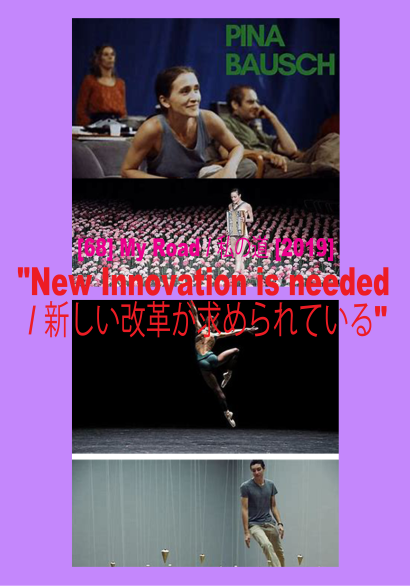
In 1992, when Butoh critic Yvonne Tenenbaum came to Tokyo from Paris, she predicted that Japanese contemporary dancers would not be attracted to her, so it would decline soon. The reason is that Butoh and Western contemporary dance, the concepts are completely different, live together vaguely and are not fresh. Now, as she predicted, contemporary dance is dying in Japan. The biggest reason is that it is not evaluated overseas. If we lose the world where the excellent work is valued and admired, we lose the competition. Even if we praise each other in the domestic circle, it will not last long. The responsibility exists with the helpless dance critics. They have not investigated the cause of the decline of Butoh in Japan, have vaguely loved Butoh, and vaguely praised young contemporary dancers. Also, even the dancers who have turned inward lack the vitality to jump out of Japan.
1992年、舞踏評論家でもあるパリのイボンヌ・テネンバウムが東京に来た時、日本人のコンテンポラリーダンサーには魅力を感じない為、その内に衰退するのではと予言していた。コンセプトが全く異なる舞踏と欧米のコンテンポラリーダンスが曖昧に同居し、新鮮ではないとの理由だ。いま、彼女の予言通り、国内ではコンテンポラリーダンスが死につつある。海外で評価されない事が最大の理由である。優れた作品が評価されたり賞賛されたりする世界を失えば、誰もが張り合いを失くす。国内で内輪で褒め合っていても長続きしない。その責任は無力なダンス批評家たちにもある。彼らは国内での舞踏衰退の原因を究めず、曖昧に舞踏を愛し続け、曖昧に若手のコンテンポラリーダンサーたちを誉め続けてきたからだ。内向きになってしまったダンサーたちも、日本を飛び出す活力が乏しい。
And even in Europe and the United States, the innovation of contemporary dance is essential. Pina Bausch brought a theatrical element to dance and expands it to establish an “Individual Rise“, and William Forsythe achieved a “Dance Reconstruction” by gathering talented dancers from all over the world and destroying the essence of dance techniques on the stage, but the wave of innovation remains interrupted there. Laban in London, one of the meccas of contemporary dance, used to have produced excellent dancers, things were enough, but now it doesn’t. After graduation, the students started to complain that there was no place to work, and Laban’s prestige began to fluctuate. There is a need for new dance innovation around the world, both in Japan, in Europe, and in the United States.
そして、本家の欧米でも、コンテンポラリーダンスの改革が必須になっている。ピナ・バウシュがダンスに演劇の要素を持ち込みダンスを拡張して「個人の台頭」を確立し、ウィリアム・フォーサイスが世界中から優秀なダンサーを集め、ダンス技術のエッセンスを舞台上で壊して見せるという「ダンスの脱構築」を実現したが、改革の波はそこで中断したままである。コンテンポラリーダンスのメッカの一つ、ロンドンのラバンもかつては優秀なダンサーたちを輩出していれば事は足りたが、今ではそうも行かない。卒業後の生徒たちの口から就職先がないとの不満が社会に漏れ出し、その威信も揺らぎ始めた。日本国内、欧米を問わず、世界中でダンスの新しい改革が求められているのである。
…………………………………
[2019]
[My Road / 私の道 <67>]
“KIDS SPACE DANCE in Kyoto / こども宇宙ダンス in 京都”
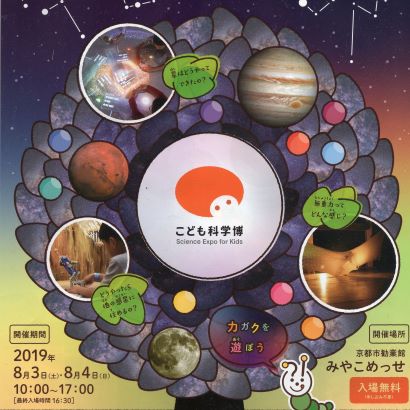
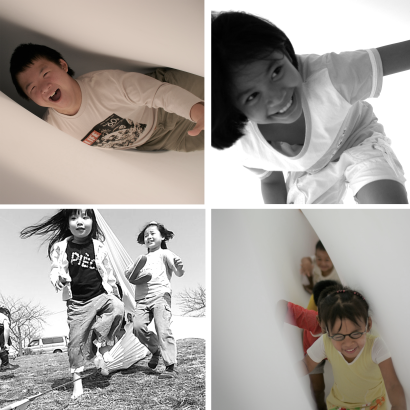
2019, I joined “KIDS SCIENCE EXPOSITION – SPACE TUNNEL” in Kyoto, Japan supported by INAMORI FOUNDATION and produced by NHK Educational and it was a great success to get 7,500 kids & parents in 2 days. I could receive a critique from the supervisor of this event Terufumi Ono, director of Mie Prefectural Museum, that “the physical experience will be important enough to become an information society and Space Tube Experience has become a valuable opportunity for it.” Due to the rapid progress of the information society, this trend that physical experience is required will be accelerated.
2019年、京都で実施した『こども宇宙博~スペーストンネル』(主催・稲盛財団、制作・NHKエデュケーショナル)では、2日間で7,500人という多くの親子が参加しスペースチューブ体験を楽しんだ。監修・大野照文(三重県総合博物館館長)からは、「情報社会になるほど身体的体験が重要になり、スペースチューブ体験はその為の貴重な機会になった」との批評を得た。情報社会の進展は急激であり、それにつれて身体的体験が求められるというこの傾向はますます加速されることになる。
…………………………………
[2018]
My Road / 私の道 [<66>]
“APAROS – AI Robot as My Alter Ego
/ アパロス – 私の分身としてのAIロボット”
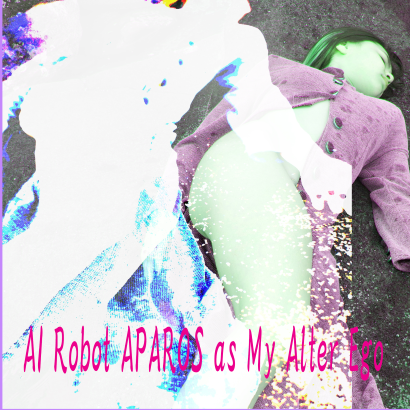
By Anita’s organization, I held “SPACE DANCE PERFORMANCE” and gave a lecture “APAROS – AI Robot as My Alter Ego” to commemorate the publication of “VISION of BODY” at the Copernicus Science Center in Warsaw.
『身体の夢』出版記念として、アニタの制作により、ワルシャワのコペルニクス科学館でアンナとスペースダンス公演を実施し、さらに「アパロス – 私の分身としてのAIロボット」と題する講演を実現できた。
I have finally entered the world of “AI robots“. The debate that “it is possible to create a robot with a heart” is becoming more and more popular in the world, and the cases are beginning to appear, but they are all just “fictions that the human side is forcing robots“. No one on earth has yet created a “Robot as an Alter Ego with a mind” in my sense.
私も、いよいよ、「AIロボット」の世界に踏み出すことになった。世界では「心をもつロボットの創造は可能である」という議論はますます盛んで、その事例の登場も始まっているが、それらは全て「人間の側がロボットに強いている虚構」に過ぎないだろう。私が言う意味での「分身としての心をもつロボット」を誕生させた者は、まだこの地上で一人もいないだろう。
…………………………………
[2018]
[My Road / 私の道 <65>]
“VISION of BODY / 身体の夢”
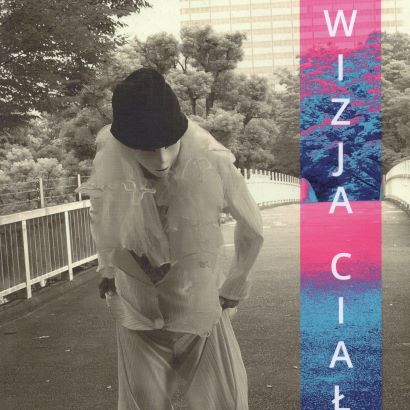
2018, by Anita who has been indebted to me, my book “VISION of BODY” was published as English & Polish version in Warsaw, Poland. It’s very important and a great honor for me. But this book is still incomplete. I have started to write “VISION of BODY on Earth and in Space” as English & Japanese version as a significant augmentation of this book.
2018年、この間お世話になってきたアニタにより、私の『身体の夢』が英語&ポーランド語版としてワルシャワで出版された。私には大切で、とても光栄な事。でもまだこの本は未完成。私は今、これの大幅な増補版として『身体の夢~地上で、そして宇宙で』(日本語&英語版)の執筆を始めている。
…………………………………
[2018]
[My Road / 私の道 <64>]
“KIDS SPACE DANCE / こども宇宙ダンス”
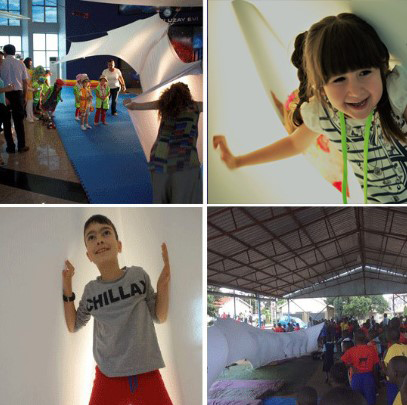

“Space Tube Experience” will be a very educational chance for the kids. Sure, if the kids will start to enjoy Space Tube from young age they can develop several interesting acute senses and abilities for their life.
スペースチューブ体験は、子供たちに貴重な教育的機会を与える。もし子供たちがごく小さな時からこの体験を楽しみ始めるなら、彼らは興味深いさまざまな新しく鋭い感覚を身につけることになるだろう。
Above all, through this experience the kids can get back the physical sensation, so we help to solve the “Social Problem of the Loss of Physicality in Information Society“. In other words, the kids can learn naturally about the “Distinction between Real and Virtual” which becomes difficult to understand for anyone where the virtualization by the technology such as Virtual Reality, Augmented Reality, AI, and Robotics rapidly progresses.
何よりも、子供たちは、この体験を通じて身体感覚を取り戻すことができるので、「情報社会における身体感覚の喪失」という現代社会において懸案になっている社会的問題の解決に役立つ。子供たちは、誰にとってもその識別が困難になりつつある「リアルとバーチャルの差」について、スペースチューブの中で遊んでいる内に自然に学ぶことができるのである。
…………………………………
[2018]
[My Road / 私の道 <63>]
“SPACE DANCE in the Tube / スペースダンス・イン・ザ・チューブ”
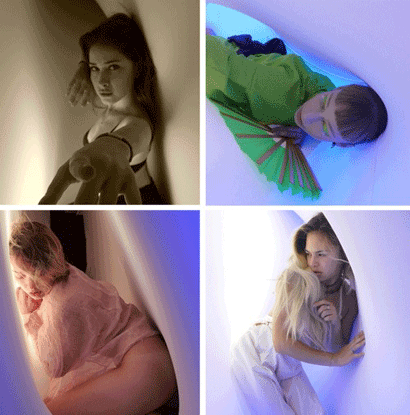
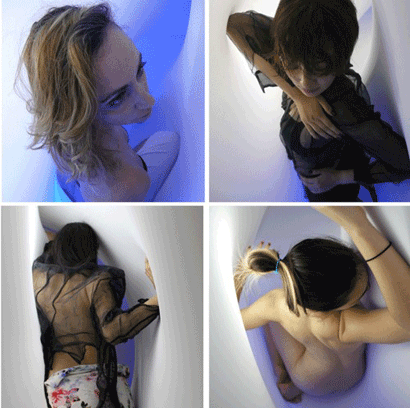
“Space Dance in Space Tube” is a media to realize our concept of “Design after Dance“ and is the decisive driving force for the Plan of Space Dance & Design Museum. In Space Tube we can experience a very amicable relationship between the body and the space. So, we can feel the nostalgia as if we return back to the mother’s womb and we can get back several our lost memories. Then, we can create new dances that we have never experienced before supported by new visions with more big energies from the space.
「スペースダンス in スペースチューブ」は、「ダンスの後にデザインが生まれる」というコンセプトを実現できるダンスであり、スペースダンス&デザインミュージアム計画の為の決定的な動力になった。スペースチューブの中では、身体と空間の間の親密な関係を体験でき、まるで母の胎内に帰ったような郷愁を感じ、失った多くの記憶を回復できる。そのため、私たちは空間からエネルギーを吸収し、これまで経験したことがない新しいダンスを創造できる。
…………………………………
[2018]
[My Road / 私の道 <62>]
“SPACE DANCE, at Outside / スペースダンス、外で”
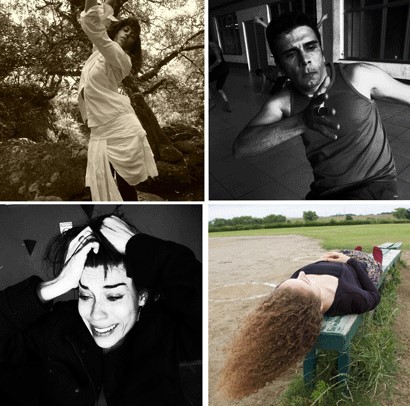
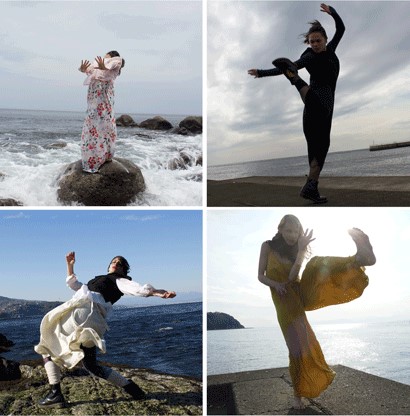
We can develop each dances as Space Dancers more easy at outside location with their hidden charms. Because in our today’s world, the theaters, the museums, the studios and so on have almost same environments and same information. But, sure, we need different environments and different information based on each dancers to develop each dancer’s characteristic dances.
私は、個々のダンサーが自分にも隠されている魅力を発揮するスペースダンサーとして育つためには、室内よりも屋外のロケーションがより容易になると考えた。それは、個々のダンサーの個性が開花すためには、 個々のダンサー に根差した異なった環境と情報が必要であるにもかかわらず、今日では世界中の劇場も、美術館も、スタジオも、ほぼ同様な環境と情報に満たされてしまっているからである。
…………………………………
[2018]
[My Road / 私の道 <61>]
“SPACE DANCE Catalog / スペースダンス・カタログ”
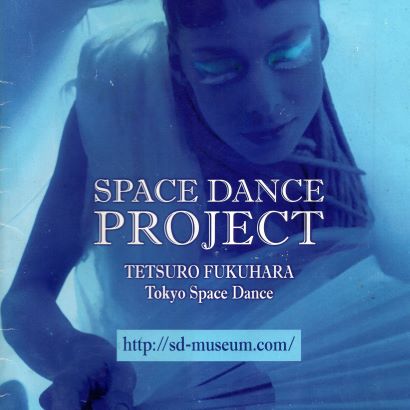
Space Dance Catalog introduced “SPACE DANCE, at Outside” “SPACE DANCE in the Tube” “KIDS SPACE DANCE” in detail that these three cases are important achievements of the Tokyo Space Dance activities. And our goal is to open SPACE DANCE & DESIGN MUSEUM which is based on these achievements.
スペースダンス・カタログは、「スペースダンス、外で」「スペースダンス・イン・ザ・チューブ」「こども宇宙ダンス」の3件が、これまでの東京スペースダンス活動の重要な成果である事を詳しく紹介している。私たちのゴールは、これらの成果の上に成立するスペースダンス&デザインミュージアムの開館にある。
…………………………………
[2018]
[My Road / 私の道 <60>]
“SPACE DANCE of Angharad Matthews
/ Angharad Matthewsのスペースダンス”
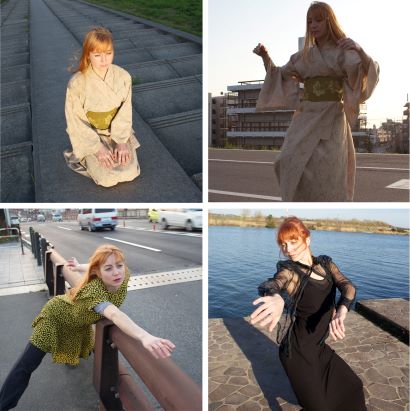

Angharad Matthews(nickname: Angus) was a participant when my best friend Eeva produced my workshop in a studio in the beautiful mountains of Wales. After that, Angus came to Japan and danced with me in Tokyo, Manazuru Sea, Yahiko Shrine (Niigata) and Kyoto, and I took the pictures of her. She is also an actress, delicate but powerful, a divine dancer who enters the trance state and is a beautiful dancer, she appears to have multiple personalities from my view. I am looking forward to seeing how she will grow in the future as she gains Space Dance as a lifelong treasure.
Angharad Matthews(綽名・アングス)は、親友・エヴァがウェールズの美しい山間にあるスタジオで私のワークショップを制作してくれた時の参加者。アングスはその後日本に来て、東京・真鶴海岸・弥彦神社(新潟)・京都で私とダンスし、私は彼女の写真を撮った。彼女は、女優でもあり、清楚な反面、力強く、神がかったダンスによりトランス状態にも入り、私には複数の人格を持つようにも見える美しいダンサーである。スペースダンスという生涯の宝を得た彼女が今後どのように成長していくか、私は楽しみにしている。
…………………………………
[2018]
[My Road / 私の道 <59>]
“SPACE DANCE of Najeri / ナジェリのスペースダンス”
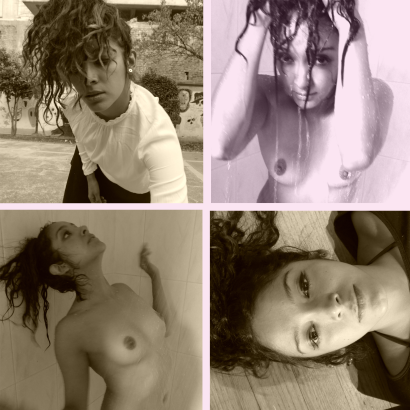
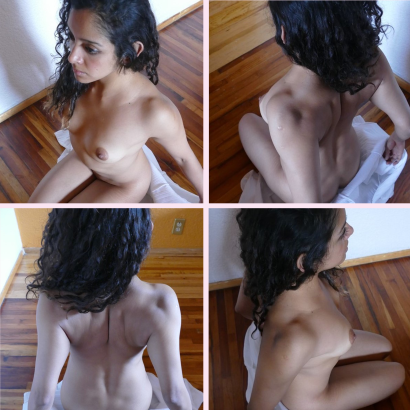
Nageri, who came to participate in my workshop in Mexico City in a separate relationship with Laura. Like Laura, she is also open to nudity, and her dance is also wonderful as a way to release the passion hidden inside her. When she stops dancing, she returns to being a normal, quiet woman, but where does her strength come from? It seems to me that she have a deep well of expression that I cannot imagine as Japanese.
ラウラとは別の関係でメキシコシティでの私のワークショップに参加するようになったナジェリ。彼女もまたラウラと同じく裸体に対して開放的で、ダンスもまた内に秘めた情熱の発散として素晴らしい。ダンスをやめればごく普通の大人しい女性に戻るのに、その強さは一体どこから来るのか。日本人の私には到底理解できない表現のための深い井戸を持っているように思える。
…………………………………………..
[2018]
[My Road / 私の道 <58>]
“SPACE DANCE of Anjah Ki-hai / Anjah Ki-haiのスペースダンス”
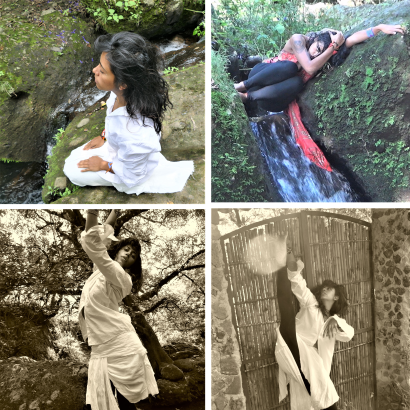
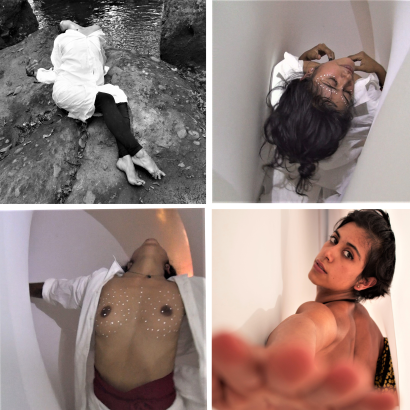
Photos of Anjah Ki-hai I took in the suburbs of Mexico City. She is a Colombian-based dancer, I met her first time when she attended my workshop in Havana, Cuba in 2013, and also attended my workshop in Mexico City. A dancer who combines sophisticated dance techniques with wildness and open sexuality. This is the first time she has danced outdoors in earnest, and she has continued to perform with wonderful activities year by year.
メキシコシティ郊外で私が撮影したAnjah Ki-haiの写真。彼女はコロンビアを拠点に活動するダンサーで、2013年にキューバ・ハバナで私のワークショップに参加した時に初めて会い、メキシコシティでのワークショップにも参加した。洗練されたダンステクニックと、野生と、開放的なセクシュアリティを併せ持つダンサー。本格的に屋外でダンスしたのはこの時が初めてとの事で、その後も年々と素晴らしい活動を続けている。
…………………………………
[2018]
[My Road / 私の道 <57>]
“SPACE DANCE at National Arts Center in Mexico City
/ スペースダンス at 国立アートセンター in メキシコシティ”
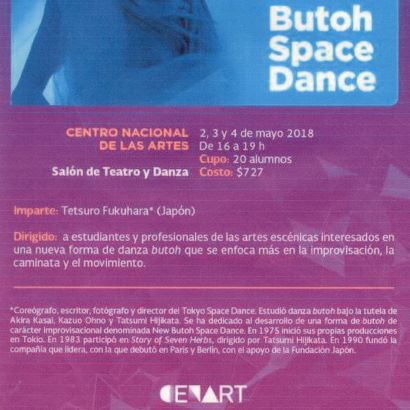
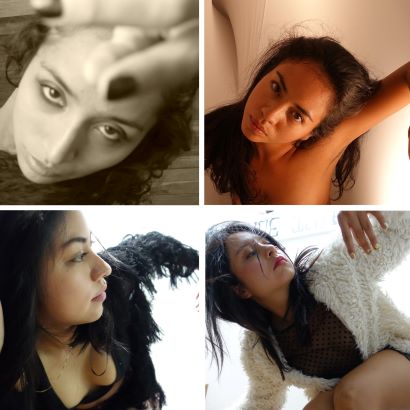
Mexico City has become my favorite city like Istanbul, and I’ve been coming every year since 2013. Western culture, including Japan, has reached one peak, so it will be difficult to create a new peak more. However, neither Mexico nor Turkey chased Western culture, and it seemed to me that at least the young people in Mexico City and Istanbul who attended my workshop had the “Chaos needed to create Culture.” Therefore, they have no dark shadows in their minds and are insanely energetic compared to young people in Japan and the West. I, who also need “Chaos”, naturally feel better when mixed with them.
メキシコシティもイスタンブールと並ぶ私のお気に入りの都市になり、2013年以来、私は毎年来るようになった。日本を含め、欧米文化は一つの頂点に達してしまい、それ以上のものを創造することが困難になっている。しかし、メキシコもトルコも欧米文化を追いかけるわけではなく、少なくとも私のワークショップに参加したメキシコシティとイスタンブールの若者たちは「文化創造に必要なカオス」を抱えている、と私には思われた。そのため、彼らは日本や欧米の若者に比べ、心に暗い影がなく、めちゃくちゃに元気だ。カオスを必要としている私も、彼らに混じっていると自然に元気になっている。
In Mexico City, Laura, Angel, Anna, and Mets, who made me feel the high potential as a space dancer. I have had a long relationship with Laura, who works as my assistant every year. Angel, who dances like a pop. Anna, who looks at people with incredibly beautiful and strong eyes. Mets, who has a model sense and likes Japanese culture. But, I got a sad news from Mets that Anna died after my leaving to Japan. I still can’t believe it, she was so young and so fine. The dead Anna has become a member of the same surplus dimension that Elena lives in, so she appears in my work many times.
メキシコシティで、スペースダンサーとしての高い可能性を感じさせたラウラ・エンジェル・アナ・メッテの4人。毎年私の助手をつとめてくれるラウラとは長い付き合いになった。弾けるようなダンスをするエンジェル。信じられないほど美しくつよい目の光を放って人を見るアナ。モデルセンスを持ち、日本文化も好きなメッテ。しかし、アナは、私が日本に帰国してからすぐに死んだという悲しいニュースをメッテから聞いた。今でも信じられない。あんなに元気だったのに。死んだアナは、私にはエレナが住む同じ余剰次元の一員になったので、私の作品にも頻繫に登場するようになっている。
…………………………………
[2017]
[My Road / 私の道 <56>]
“SPACE DANCE at Tama-Rokuto Scinece Center
/ スペースダンス at 多摩六都科学館”
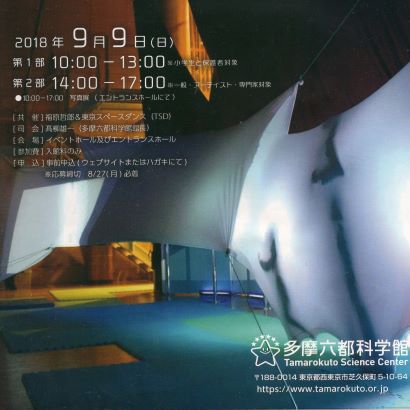
In 2017, I held “SPACE DANCE PERFORMANCE”, “KIDS SPACE DANCE”, and lecture at Tama-Rokuto Science Center with a title “SPACE DANCE – when we look at the earth from a space perspective.” Shiro Mitsumori and Yohei Yagi participated from JAXA, and Yagi in particular gave a lecture of his impressions of his Space Tube experience from the standpoint of a blind researcher.
東京の多摩六都科学館で、「スペースダンス~宇宙視点から地球を見ると」と題してスペースダンス公演・こども宇宙ダンス・レクチャー・展示を実施した。JAXAからは光盛史郎と八木陽平の両氏が参加し、特に八木氏には盲目の研究者としての立場からスペースチューブ体験の感想を発表してもらった。
Also, tombo, aikito, Masako, Kaori Ishiguro, Pinar Sinka, and Joana Chicau joined Space Dance Performance. Joana collaborated with me as a media artist to try to express the movements in Space Tube and dancers using Kinect as a “Body-Space Model.” The following is a recommendation for the Space Tube experience by Director Takayanagi.
公演にはtombo、akito、マサコ、石黒香、ピナール・シンカ、ジョアナ・チカウが参加した。ジョアナはメディアアーティストとして私と協働し、Kinectを使用して、スペースチューブとダンサーの動きを「身体-空間モデル」として表現する試みに挑戦した。以下は高柳館長によるスペースチューブ体験への推薦文である。
”GPS, meteorological satellite, broadcasting satellite · · ·. For us who live in the ocean of countless information, opportunities to conscious of the workings of sensibility directly knowing the environment in the body are rapidly decreasing, and opportunities to feel conscious of the work of sensitivity to human beings becomes precious as much There. The experience of self-awareness of the world with Space Tube and the attempt to express it through the whole body must be an adventure to revive the sensitivity that is buried under consciousness and to know the new world that can be shared by the group. I would like to encourage many of you to experience Space Tube.”
「GPS、気象衛星、放送衛星・・。無数の情報の海に生きる私たちにとって、身体で直接環境を知る感性の働きを意識する機会は急激に減少しつつあり、人間にとって感性の働きを意識して感じる機会はそれだけ貴重なものになっている。スペースチューブを使った身体全体による世界の自覚体験、それによる表現の試みは意識下に埋もれている感性を蘇らせ、集団で共有できる新たな世界を知る冒険になるに違いない。多くの皆さんの体験的参加を呼びかけたい」。
…………………………………
[2016]
[My Road / 私の道 <55>]
“KIDS SPACE DANCE at Museum of Contemporary Art Tokyo
/ こども宇宙ダンス at 東京都現代美術館”
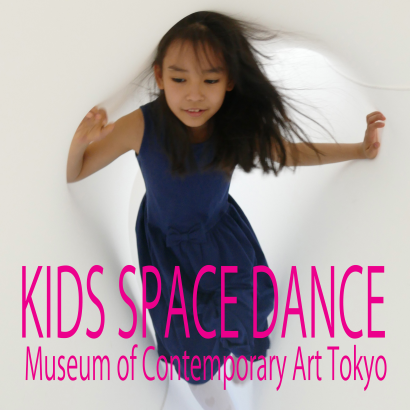
In the summer of 2016, “KIDS SPACE DANCE” at Museum of Contemporary Art Tokyo was realized by the invitation of Motoko Uchitomi, who cared me during my last joint research with JAXA. In the three months from July to September, so many 60,000 people, mainly parents and children, enjoyed the Space Tube experience.
2016年・夏、JAXAとの共同研究の時にお世話になった内富素子さんの誘いで、「こども宇宙ダンス at 東京都現代美術館」が実現した。7月~9月の3ヶ月で6万人という、親子を中心とした多くの参加者がスペースチューブ体験を楽しんだ。
What was interesting here was that in front of the Space Tube experience booth, the most recommended video work of the museum with a large budget by Team Lab was exhibited, but the audiences were passed it easily, and there was a long line at our booth, which became a hot topic. This reaction of the audience seemed to be surprising even for the museum, and it was a meaningful experience for us. How are the two needed now in our world? What is the difference between video experience and physical experience? It will be an important question day by day.
ここで面白い現象だったのは、スペースチューブ体験ブースの手前には今を時めくチームラボによる大予算をかけた館の一番のお勧めの映像作品が展示されていたが、観客はその前はあっさりと通り過ぎ、私たちのブースに長い行列が出来て話題になった事。館としても観客のこの反応は意外だった様子で、私たちには意味深い経験になった。映像体験と身体的体験。その二つは今私たちの世界でどのように必要とされているのか? その差は何か? 日に日に重要な問いになっていくだろう。
…………………………………
[2016]
[My Road / 私の道 <54>]
“SPACE DANCE of Anna Juniewicz
/ Anna Juniewiczのスペースダンス”
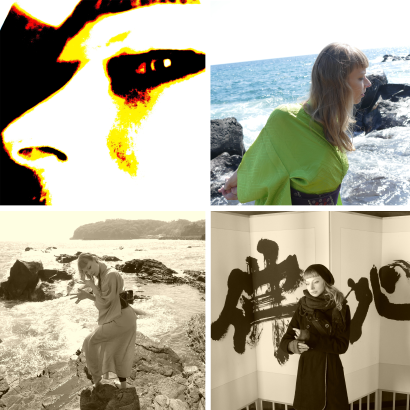
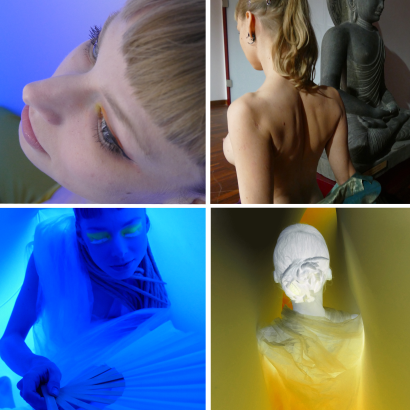
I became friends with Anna Juniewicz, one of the workshop participants in Warsaw, in the same way as Masako. Anna is active as a performer as well as an E-learning coordinator. With a beautiful and sharp look and an intellectual sense reminiscent of a mathematician, I was surprised with her. I invited her to Tokyo and filmed her dance in various locations, just like Masako. Her dance was delicate, sharp, like alien in another world and same time very sexual woman, and she reminded me that there aren’t many dancers in the world with such beauty. She also became a Space Dancer I took the most pictures.
私のワルシャワでのワークショップ参加者の一人・アンナとは、マサコと同じような経緯で仲良くなった。彼女はパフォーマーとして活躍すると共に、E-learningコーディネーターとしても働いている。美しく鋭い顔つきと、数学者を思わせるような知的センスを持っていて、私は彼女に驚いた。私は彼女を東京に招待し、マサコと同じようにいろんなロケーションで彼女のダンスを撮影した。そのダンスは、繊細で、鋭く、異界的であると共にセクシュアリティに溢れ、これほどの美をもつダンサーは世界にも多くはないと思わせた。彼女も、私が最も多くの写真を撮ったスペースダンサーになった。
…………………………………
[2016]
[My Road / 私の道 <53>]
“SPACE DANCE in Warsaw / スペースダンス in ワルシャワ”
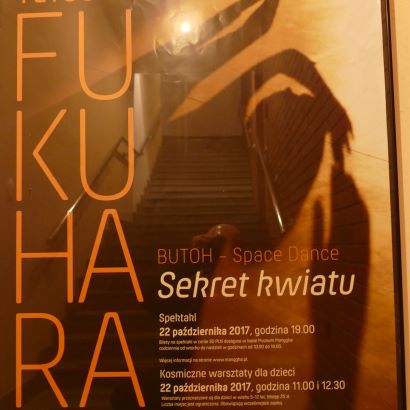
In 2015, I met Anita Zdrojewska, who was one of the audiences when I performed in Warsaw, and she was a Japanofile and took a Japanese studies at the Warsaw University, and also she was a big fan of Butoh and published a book of Kazuo Ohno, then I could become friends with her. In 2016, Anita produced “SPACE DANCE WORKSHOP & PERFORMANCE” and “KIDS SPACE DANCE” in Warsaw.
2015年、私がワルシャワで公演した時に観客の一人だったアニタと知り合い、彼女が大学で日本学を専攻した大の親日家である事、また舞踏の大ファンで大野一雄の本も出版している事から、仲良くなった。その縁で、2016年、彼女がスペースダンスワークショップ・公演・こども宇宙ダンスを制作してくれた。
…………………………………
[2016]
[My Road / 私の道 <52>]
“SPACE DANCE at CER Museum in Ankara, Turkey
/ スペースダンス at CER現代美術館、アンカラ・トルコ”
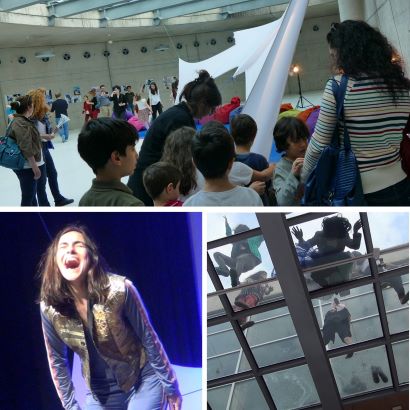
2016, produced by Gulsha, young excelent architect, I held “SPACE DANCE WORKSHOP & PERFORMANCE“, “KIDS SPACE DANCE“, and “Exhibition” at her university and CER Museum in Ankara, capital of Turkey. Gulsha, like Filiz, graduated also the architectural department of Istanbul University. It was an event that reaffirmed the need for multi-talented human resources who like dance and architecture for Space Dance.
トルコの首都・アンカラのCER現代美術館での、スペースダンス公演と「こども宇宙ダンス」。優れた若手建築家・ギューシャが、彼女が教える中東工科大学でのワークショップとCER現代美術館での公演を制作してくれた。ギューシャもフィリッツと同じくイスタンブール大学の建築学部卒業。スペースダンスには、ダンスも好き、建築も好きというマルチタレントの人材が必要な事を再確認したイベントだった。
…………………………………
[2015]
[My Road / 私の道 <51>]
“SPACE DANCE at Eskisehir Science Center
/ スペースダンス at エスキシェヒール科学センター”
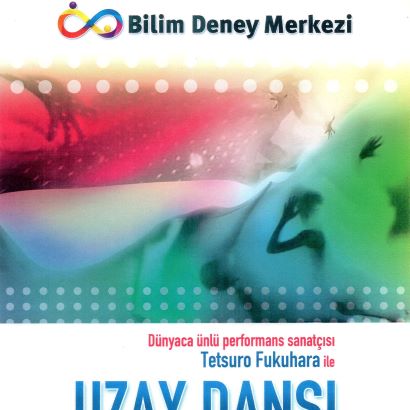

2015, I held “SPACE DANCE WORKSHOP & PERFORMACE“, “KIDS SPACE DANCE“, and “Exhibition” as an event with a complete set of space dance projects produced by my dear friend Filiz Sizanli at her university and the Science Museum in Eskisehir, cultural city of central Turkey where she lives. Filitz is a well-known contemporary dancer in Turkey who graduated from the faculty of architecture of Istanbul University, and has a deep understanding of Space Tube. So,I asked her to challenge to make a collaboration called “Multiform Posture Formation” with her dance and a chair in Space Tube. Even in “KIDS SPACE DANCE”, there were many repeaters and the number of participants increased day by day due to word of mouth.
2015年、親友・フィリッツの制作で、彼女が住むトルコ中部の文化都市・エスキシェヒールの大学と科学館で、ワークショップ・公演・こども宇宙ダンス・展示とスペースダンスプロジェクトの一式が揃ったイベントを実施した。フィリッツは、イスタンブール大学の建築学部を卒業したトルコでは有名なコンテンポラリーダンサーで、スペースチューブに対する理解は深い為、スペースチューブの中でイスとのコラボによる「多様な姿勢形成」というワークショップに挑戦してもらった。こども宇宙ダンスでも、リピーターが多く、口コミで日に日に参加者が増加した。
…………………………………
[2015]
[My Road / 私の道 <50>]
“SPACE DANCE of Masako Takeda Gray
/ Masako Takeda Grayのスペースダンス”
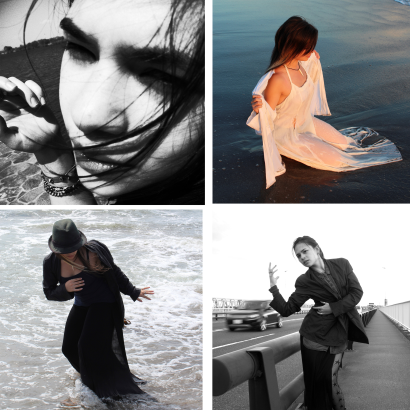

Masako Takeda. She was one of participants when I held a Space Dance Workshop on a road in London with the students of Laban. Her father is Englishman and her mother is Japanese. I was impressed not only by her wonderful dance, but also by her unique look and eyes, so I nicknamed her “The Princess of the White Wolf Country“. Since then, she has come to Tokyo every summer and has continued to shoot her dance in various locations. Along with Anna in Warsaw, she is a Space Dancer who I took the most pictures.
マサコ・竹田。私がラバンのダンス学生たちとロンドンの路上でワークショップを実施した時の参加者の一人。父がイギリス人、母が日本人。ダンスの素晴らしさだけではなく、その顔つきと目つきが独特でつよい印象を受け、私は「白いオオカミの国の姫」と綽名をつけた。以来、彼女は毎年夏に東京に来るようになり、いろんなロケーションで彼女のダンスの撮影を続けた。ワルシャワのアンナと共に、私が最も多くの写真を撮ったスペースダンサーである。
…………………………………
[2014]
[My Road / 私の道 <49>]
“SPACE DANCE at SESC Modern Museum in Sao Paulo, Brazil
/ スペースダンス at SESC現代美術館、サンパウロ・ブラジル”
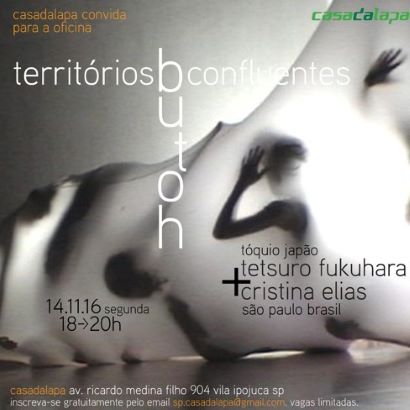
2014, I held “SPACE DANCE WORKSHOP & PERFORMANCE” and “KIDS SPACE DANCE” at SESC Modern Museum in Sao Paulo, Brazil produced by Cristina Elias and her husband Cesar. Christina is a popular assistant professor who is pioneering a new field of physical expression at her university, and many of her students attended my workshop. Cesar is a media artist who is also active in Europe and has coordinated this event.
ローマで知り合ったクリスティーナ・エリアスと夫のセザールが制作してくれた、ブラジル・サンパウロのSESC現代美術館でのスペースダンスワークショップ・公演と、「こども宇宙ダンス」。クリスティーナは大学で身体表現の新領域を開拓している人気の助教授で、彼女の多くの生徒がワークショップに参加した。セザールはヨーロッパでも活躍するメディアアーティストで、このイベントの調整役を務めてくれた。
…………………………………
[2013]
[My Road / 私の道 <48>]
“KIDS SPACE DANCE at Yamananshi Science Museum
/ こども宇宙ダンス at 山梨県立科学館”
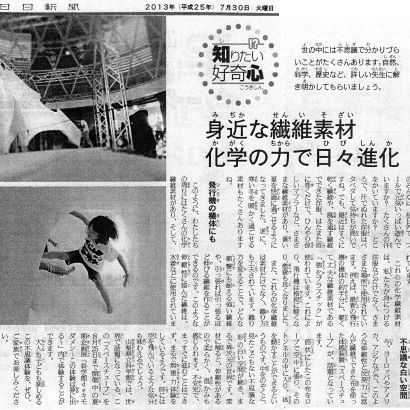
In 2012, “KIDS SPACE DANCE” was held as part of the event at Yamanashi Science Museum, but in 2013, it was held independently because “there are many requests for Space Tube”. During the summer vacation, about 1,000 parents and children a day enjoyed Space Tube Experience. The curator in charge, Megumi Sugiyama, had a wonderful understanding, and the following newspaper article was published by her.
2012年は山梨県立科学館のイベントの一部としての実施だったが、2013年には「スペースチューブへのリクエストが多い」との理由で、「こども宇宙ダンス」が単独に実施された。夏休みの期間中、1日約1000人の多くの親子がスペースチューブ体験を楽しんだ。担当キュレーター・杉山恵の理解が素晴らしく、彼女による以下の新聞記事が出た。
”Space Tube that has become a hot topic in the world. If we look inside, we will see a mysterious white space that we have never seen, and it is like a world of a different dimension. When we touch the material, it is elastic and soft, and we can feel the warmth. It’s unstable, we can’t go straight, and it’s like we are experiencing weightlessness. Sometimes we can feel like we are flying in the sky.”
「世界で話題になっているスペースチューブ。中を覗くと、見たこともない不思議な形の白い空間が続き、まるで異次元の世界です。素材に触ると、伸縮性があるので柔らかく、温かみも感じられます。不安定で、真っ直ぐに進むことは出来ず、まるで無重力体験をしているようです。時には空を飛んでいるような気分も味わえるでしょう」。
…………………………………
[2013]
My Road / 私の道[ <47>]
“SPACE DANCE in Bangkok / スペースダンス in バンコク”
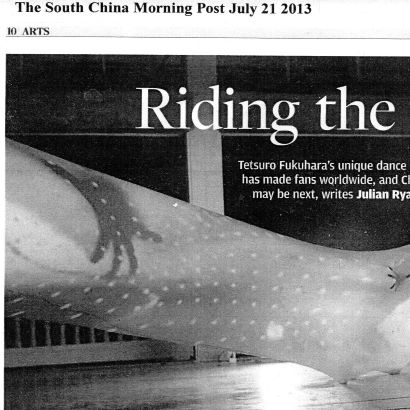
In 2013, I held “SPACE DANCE Performance” and “KIDS SPACE DANCE” at National Theater and several primary schools in Bangkok supported by the Japan Foundation, Ministry of Foreign Affairs Asian and Oceanian Affairs Bureau, and Japanese Embassy. Through this relations I could hold it in Singapore and Kuala Lumpur, Malaysia. The following article entitled “Rediscovering the Body” was published in the Bangkok Post.
国際交流基金・外務省アジア大洋州局・日本大使館によるタイの首都・バンコクのパトラバティ劇場でのスペースダンス公演と、複数の小学校での「こども宇宙ダンス」。これが縁でシンガポールやマレーシアのクアラルンプールでも実施できた。バンコク・ポストに「身体の再発見」と題する以下の記事が出た。
”Space Dance Workshops and Performances are the steps to reconnect human needs in the information society to the body, and above all, to secure the reality that humans need without being confused by the virtual world. It taught that we need to Return to the Body.”
「スペースダンスによるワークショップと公演とは、情報社会における人間の欲求をふたたび身体に結びつけるためのステップであり、仮想世界に惑わされることなく人間に必要なリアリティを確保していくためには、何よりも「身体に戻る」必要があることを教えていた」。
…………………………………
[2009]
[My Road / 私の道 <46>]
“KIDS SPACE DANCE in the World and in Japan
/ こども宇宙ダンス~世界と日本で”
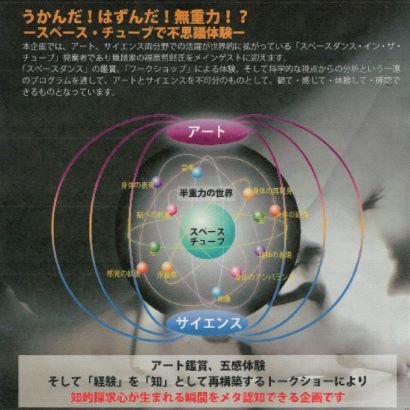
2009-2013, I held “KIDS SPACE DANCE” in overseas, in Brussels, Monako, New York, Kampala, Nairobi, London, Santiago, Havana, Mexico City, Rio de Janeiro, and Roma at several primary schools and galleries. Also in Japan, I held it at Sendai Kids Space Museum, Space World, Kids Theater in Mie, Asahi Art Square, National Graduate Institute for Policy Studies, Aeon Mall in Japan, Mitaka Tenmei Hanten-chi, Earth Expo Memorial Park, Arts Gallery in Kawaguchi, Niigata Science Museum, Fukui Children’s Science Museum, and Nagoya Dome. No matter where I went, there were many repeaters who once experienced a Space Tube and then came back again, and there was a long line of children in front of a Space Tube.
2009年~2013年、海外では、ブリュッセル・モナコ・ニューヨーク・パリ・イスタンブール・カンパラ・ナイロビ・ロンドン・サンティアゴ・ハバナ・メキシコシティ・リオデジャネイロ・ローマなどの小学校やギャラリーで、国内では仙台市こども宇宙館・スペースワールド・みえこどもの城・アサヒアートスクウェア・政策研究大学院大学・各地のイオンモール・三鷹天命反転住宅・地球博記念公園・川口市アートギャラリー・新潟県立自然科学館・福井児童科学館・ナゴヤドームなどで、「こども宇宙ダンス」を実施した。どこに行っても、一度体験したらまた戻って来るというリピーターが多く、スペースチューブの前には子供たちの長い行列ができていた。
…………………………………
[2008]
My Road / 私の道[ <45>]
“SPACE DANCE – Create a New Body
/ 『宇宙ダンス~新しい身体をつくる』”
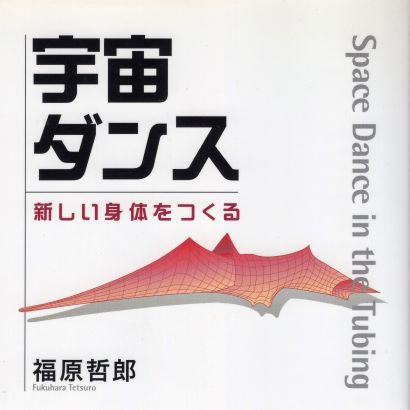
2008, My book “SPACE DANCE – Create a New Body” was published by Shunjusha publishing company in Tokyo. The idea that I have cultivated so far is accumulated in the content that “New Thought” that emphasizes physicality is useful not only for space development but also for solving problems that occur in the information society and problems related to body modification. It became a memorable book. Also. as a Space Dance artist, it was a time when I was able to jump out into a new world that I had never experienced before by analyzing closely dance as “Creating a Posture.”
2008年、東京の春秋社から、私の『宇宙ダンス~新しい身体をつくる』が出版された。身体性を重視した「新しい知」が、宇宙開発だけではなく、情報社会で発生する問題や身体改造の在り方を巡る問題の解決にも役立つという内容で、私がこれまで培ってきた思想が集積された記念すべき本になった。舞踏家としても、ダンスを「姿勢の創造」と読み解くことで、これまで経験したことがない新しい世界に飛び出す事が出来た時期である。
…………………………………
[2007]
[My Road / 私の道 <44>]
“Pleasure of DANCE / ダンスの喜び”
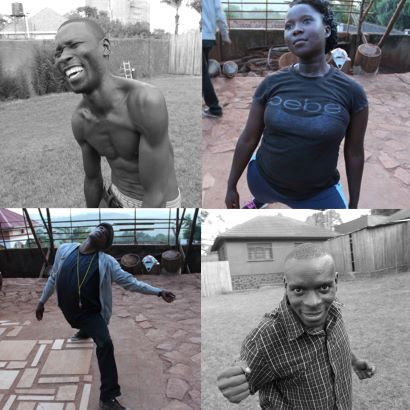

The power of African dancers was just as great as I had heard in rumors. Men and women, they were just connected to the earth, and no matter how much they danced, they pumped energy from the earth and seemed tireless. I especially made friends with Kibe and he took care of me every year when I came to Kampala.
アフリカのダンサーたちが持つパワーは、噂に聞いていた通りで素晴らしかった。男も、女も、まさに彼らは大地に接続された者たちで、どれだけダンスしても大地からエネルギーをくみ上げ、疲れを知らないようだった。私は特にキベと仲良くなり、彼が毎年私がカンパラに来る時の世話役をやってくれた。
And, African children were enjoyed Space Tube experience so much. There was a mountain of people in front of Space Tube, and the power they radiated was amazing. They were so energetic that somehow my tears came out while watching them, they were so engrossed and enjoyed.
そして、スペースチューブ体験を楽しむアフリカの子供たち。スペースチューブの前にはまさに山のような人だかりが出来、彼らが発散するパワーは凄かった。あまりにも彼らは元気で、こんなに夢中になって楽しんでくれる彼らを見ている内に、なぜか涙が出てきた。
…………………………………
[2007]
[My Road / 私の道 <43>]
“At the ground of Africa / アフリカの地で”
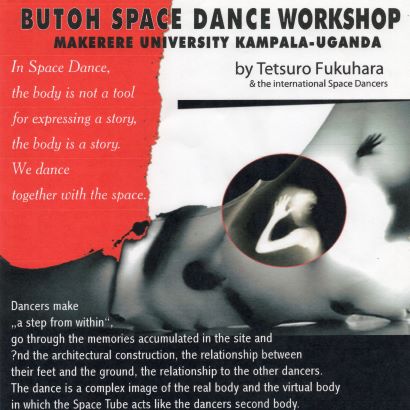
In 2007, I held “SPACE DANCE Performance” and “KIDS SPACE DANCE” at National Theater and several primary schools in Kampala, capital of Uganda supported by United Nations Uganda Office, Japanese Embassy, and JICA. I also held “KIDS SPACE DANCE” in Nairobi, Kenya. My first experience of Africa. I got up early every morning and enjoyed the beautiful “African Morning” atmosphere. The temperature is high, but the wet is low, so a wonderful and refreshing wind blows. I could get the following comment from United Nations Uganda Office;
2007年、国連ウガンダ事務所・日本大使館・JICAによるウガンダの首都・カンパラの国立劇場でのスペースダンス公演と、複数の小学校での「こども宇宙ダンス」。「こども宇宙ダンス」はケニアの首都・ナイロビでも実施された。私には初めてのアフリカ体験。毎朝早起きして、美しい「アフリカの朝」の雰囲気を味わった。気温は高いが、湿気が少ないので、素晴らしく爽やかな風が吹く。国連ウガンダ事務所からは以下のコメントが出た。
”Space Dance in the Tube” was a truly unique project. It also served as a healing tool for the various “Hurts” found in conflict areas in some schools. It could provide new opportunities for children in need of rehabilitation threatened by armed soldiers and vulnerable young people who became orphans in the war to rebuild their “heart”.
「スペースダンス・イン・ザ・チューブ」は、実にユニークなプロジェクトでした。それは、いくつかの学校において、紛争地域に特有に見られるさまざまな「傷」に対する癒しのツールとしても機能していたからです。それは、武装兵士に脅かされ心的障害を負ったリハビリを必要とする子供たちや、戦争孤児になった傷つきやすい若者たちに対して、その「心」を立て直すための新しい機会を提供できたのです。
…………………………………
[2006]
[My Road / 私の道 <42>]
“SPACE DANCE, Someday in the Universe / 或る日、宇宙で”
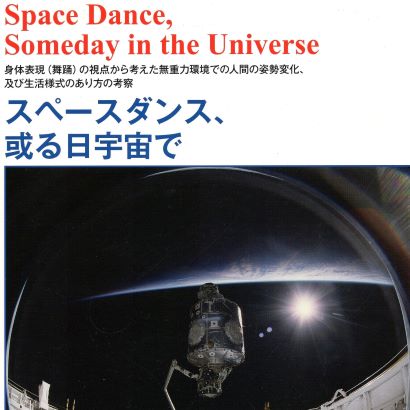
In 2006, two and a half years of joint research with the Japan Aerospace Exploration Agency (JAXA) was completed, and I presented its results at the Tokyo Design Center in Tokyo. Also, my “Space Dance – Someday in the Universe” was published by JAXA. My proposal to JAXA is as follows, and I believe that it will be an essential method when the current preparatory space development by trained astronauts has passed and full-scale space development for ordinary people begins.
2006年、2年半の宇宙航空研究開発機構(JAXA)との共同研究が終わり、その成果を東京・五反田の東京デザインセンターで発表した。JAXAからは私の『スペースダンス~或る日宇宙で』が出版された。私のJAXAに対する提案の趣旨は以下の内容で、訓練された宇宙飛行士による現在の準備的な宇宙開発が過ぎ、普通の人びとの為の本格的な宇宙開発が始まる時にこの提案が必須の方法になると、私は信じている。
”Humans are expected to face the new evolutionary possibilities in the space environment, then “Posture-Supporting Robot” that can customize the artificial gravity can influence the state of its evolution. Because, Posture is the Mother’s Womb for Cultural Creation.”
「宇宙環境において人間は新しい進化の可能性に直面すると予想されるが、人工重力をカスタマイズできる個人用の「姿勢支援ロボット」を使用することで、その進化のあり方に影響を及ぼすことができる。「姿勢こそ文化創造の母胎」であるからである」。
…………………………………
[2004]
My Road / 私の道[ <41>]
“SPACE DANCE at the National Museum of Emerging Science and Innovation / スペースダンス at 日本科学未来館”
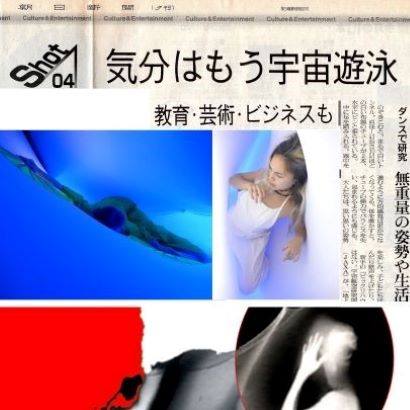
With the help from Hiroyuki Iwamoto and Shiro Mitsumori in Aerospace Exploration Agency (JAXA), the joint research began in 2004, and the first results were announced at the National Museum of Emerging Science and Innovation in Tokyo. It was also the official debut of Space Tube in Japan. It was a very important opportunity for me to recognize that “Body-Based Thinking is needed” in space development. I could know many interesting researchers and business people there, but it was my greatest asset to meet the ideas of brain scientists Jun Tani and Atsushi Iriki. I got the following comment from JAXA.
宇宙航空研究開発機構(JAXA)の岩本裕之・光盛史郎の両氏のお世話になり、2004年からJAXAで共同研究が始まり、その最初の成果発表が日本科学未来館で開催された。スペースチューブの国内での公式のデビューにもなった。宇宙開発でも「身体ベースの発想が必要になる」という事を認識でき、私には大変重要な機会になった。多くの興味深い研究者や企業人と知り合えたが、特に脳科学者の谷淳・入来篤史の両氏の考え方に出会ったことが最大の財産になった。JAXAからは以下のコメントが出た。
”An interesting feature of Tetsuro Fukuhara and Tokyo Space Dance activities is that they go beyond the boundaries of art and dance. Since the theme is to examine the lifestyle of humankind in space, we expect that it will develop into a wide range of activities such as the fusion of research in different genres and the birth of new lifestyles.”(JAXA – Space Environment Utilization Center & Tsukuba Space Center)
「芸術、舞踊という枠を超えているところが東京スペースダンス(福原哲郎)の活動の興味深い特徴です。人類の宇宙での生活様式を検討することもテーマとして挙げていることから、異なるジャンルの研究の融合や新しい生活習慣などの誕生といった幅広い活動に発展することも期待しています。 」(JAXA宇宙環境利用センター・つくば宇宙センター)
…………………………………
[2015]
[My Road / 私の道 <40>]
“SPACE DANCE of Laura / ラウラのスペースダンス”
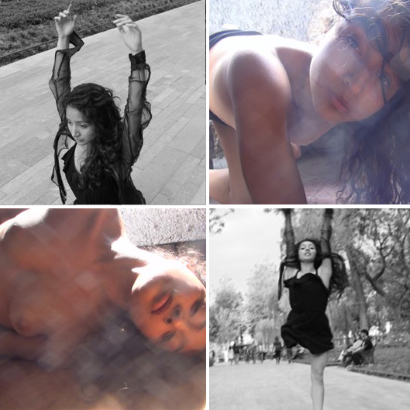

The perception of nudity varies greatly from country to country. Even in the same country, it is different depending on the times. One morning in Mexico City, a newspaper was placed on the table at a friend’s house, and when I casually saw it, there was a full-page advertisement using the naked body of a beautiful woman. I was honestly pretty surprised. This is because it is a public newspaper that is similar to Asahi Shimbun in Japan, so it is not possible in Japan. When I asked my assistant woman who came to pick me up, it wasn’t a big deal. Around the time she was born in Mexico, the country was poor, there were no regular movies in the cinema, and instead cheap pornographic movies were flooding, and children and adults watched it on a daily basis. In other words, she explained that the naked body is still familiar to the people and is not a rare object with special value.
裸体に対する認識の仕方は、国により大きく異なっている。同じ国でも時代によりまた違う。メキシコシティのある朝、友人の家のテーブルに新聞が置かれていて、何気なく見たら美しい女の裸体を使用した全面広告が掲載されていた。正直かなり驚いた。日本でいえば朝日新聞に当たるような公共新聞なので、日本ならあり得ない。迎えに来た私のアシスタントの女性に聞くと、別に大した事ではないとの事。メキシコでは彼女が生まれる前後の頃は国が貧しくて、映画館に普通の映画がなく、代わりに安価なポルノ映画が氾濫していて、子供から大人までそれを日常的に見ていたそうだ。つまり、裸体には国民が今でも慣れっこで、特別な価値をもつ珍しい対象ではないとの説明だった。
Was there such a relationship? Laura showed no resistance to getting naked in my workshop. Her naked dance, which helped her to be a delicate beautiful girl in Japanese terms, had a strange unbalance and showed a unique charm. In Japan, if the secret to improving sexuality lies in how to take off clothes and direct shame, Laura doesn’t have that, and suddenly it feels like a straight ball game, and I felt she enjoyed the beauty of her naked body by herself.
その関係もあったのか。私のワークショップで裸になる事に抵抗を示さないLaura。彼女のダンスは、彼女が日本的に言えば繊細な美少女系である事も手伝い、奇妙なアンバランスがあり、独特な魅力を発揮していた。日本ではセクシュアリティ増進の秘訣が服の脱ぎ方や羞恥心の演出にあるとすれば、Lauraにはそれがなく、いきなり直球勝負で、自分の裸体の美しさを自分で楽しんでいる感じだった。
…………………………………
[2003]
[My Road / 私の道 <39>]
“SPACE DANCE in Mexico City / スペースダンス in メキシコシティ”
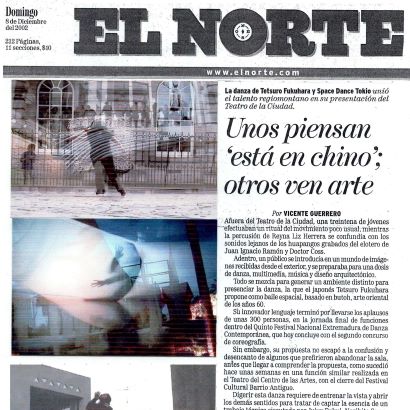
I also had a culture shock in Mexico City. Especially, the strength of the impact of the design seen in the cityscape. Mexican designers have a great sense of color, and many of the forms they choose are cool. And the openness of the workshop participants to the naked body. There were scenes of using naked bodies in my workshop, and it was a free choice, but dancers showed resistance were few. Creating a scene with a small number of dancers for Space Dance Performance has become a staple I try in any city, but when I ask the dancers “is it okay to be naked?“, there were many opportunities to have a suspicious look, “what? why?” They said that no special decision required to be naked . These reactions are completely different from country to country.
私は、メキシコシティでも大きなカルチャーショックを受けた。特に、街並みに見られるデザインのインパクトの強さ。メキシコのデザイナーたちの色彩感覚は素晴らしく、選ばれるフォルムもクールなものが多い。そして、ワークショップ参加者たちが持つ、裸体に対する開放性。ワークショップには裸体使用の場面もあり自由選択になっているが、抵抗を示したダンサーはいなかった。少数のダンサーと公演用に裸体シーンを制作することは私がどの都市に行っても試みる定番になっていたが、私がダンサーに「裸も大丈夫?」と聞くと、「えっ? なぜ?」と怪訝な顔をされる機会が多かった。裸になるのに特別の決断は要らないとの返事で、国によりこれらの対応は全く違うのだ。
…………………………………
[2002]
[My Road / 私の道 <38>]
“SPACE DANCE in Monterrey / スペースダンス in モンテレー”
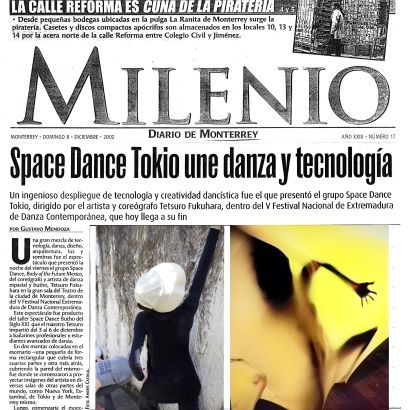
Performance in Mexico sponsored by the Japan Foundation in the cultural city, Monterey. Seeing is believing, it’s the same as the Beirut experience, I had a culture shock in Monterrey. The level of participants was high in the design and Space Dance workshops, I was honestly surprised. And, there was a lot of interest in Space Tube. One young designer took the lead to find a new cloth that was thinner, stronger, and softer than the cloth we used, and they made a new Space Tube. Also, in dance, I met wonderful dancers Vanessa and Sachi.
国際交基金の後援によるメキシコ公演、文化都市・モンテレーで。百聞は一見に如かず、ベイルート体験と同じで、私はモンテレーでもカルチャーショックを味わった。デザインとスペースダンスワークショップでも参加者のレベルは高く、私は正直驚いた。スペースチューブに対する関心も高く、一人のデザイナーが中心になり、どこからか私たちが使っていたスペースチューブの布よりも、更に薄く、強度があり、しかも触感の柔らかい布を見つけてきて新しいスペースチューブを制作してくれた。また、ダンスでも、バネッサとサチという特別に素晴らしいダンサーにめぐり逢った。
…………………………………
[2002]
[My Road / 私の道 <37>]
“With Young Architects in Tokyo / 東京、若手建築家たちと”
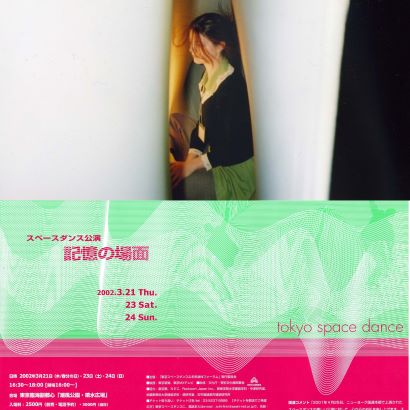
Space Tube was set up at a park of Odaiba, Tokyo, and “Memory Scene” was held with young architects such as Ryue Nishizawa and Soji Fujimoto who started to play an active role. Even in Japan, which entered the 21st century, collaboration between different fields was active, especially for architects.
東京・お台場の公園にスペースチューブを設置し、活躍を始めた西澤立衛・藤本壮司らの若手建築家たちと共に『記憶の場面』を実施した。21世紀に入った日本でも異分野間のコラボレーションは盛んであり、特に建築家には勢いがあった。
…………………………………
[2001]
[My Road / 私の道 <36>]
“New Discovery / 新しい発見”

I have been able to establish a style for the workshop while coming Istanbul every year since 2001. To me, dancing only in the classroom or in the studio was boring. I don’t think a person with good dance technique is a good dancer. This is because many of them have just been taught and become excellent students. More important than that is individuality. Excellent dance forms in individuality. However, dancers who had no choice but to compete for superiority or inferiority in dance techniques in the classroom or studio will change completely when they go out. Now, wherever we go to any city in the world, classrooms and studios are in place and the interior is full of similar information. But outside is completely different. The dancers breathe the various and different information and begin to show their individuality. Dances that fully show their individuality cannot be compared. Because they are all unique and interesting. Outside, new techniques are needed on how to bring out one’s individuality in space.
私は、2001年よりイスタンブールに毎年通う中で、ワークショップの形式を確立できた。私には、教室やスタジオでのダンスだけでは退屈だった。私は優れたダンステクニックをもつ者が優れたダンサーであるとは思わない。ただ教えられて優秀な生徒になっただけの者が多いからである。それよりも大切なのは、個性である。優れたダンスは個性に宿る。それが、教室やスタジオではダンステクニックの優劣を競うしかなくなっていたダンサーたちが、どんなダンサーも、外に出ると一変する。今では世界のどんな都市に行っても、教室やスタジオは整備され内部はどこも同じような情報に溢れている。しかし、外は全く違う。ダンサーたちはその多様な情報を呼吸し、夫々の個性を発揮し始める。個性が充分に発揮されたダンスは優劣を比較できない。どれもユニークで面白いからである。外では、どう自分の個性を引き出すかという新しいテクニックが求められるのである。
In Istanbul, after dancing in the classroom or studio, invite the willing students and participants to dance at the KARAKOY port at first, next, dance on a boat across the BOSPORUS, and finally, dance at the KADIKOY port. This has become a standard course. For years on this course, I’ve seen so many people be born as nice space dancers.
イスタンブールでは、教室やスタジオでダンスした後、有志の生徒や参加者を誘い、カラキョイの船着き場でダンスし、ボスポラス海峡を渡るボートの上でダンスし、最後にカディキョイの船着き場でダンスする。これが定番コースになった。私はこのコースで何年もの間、多くの者が素晴らしいスペースダンサーとして誕生する光景を見てきた。
…………………………………
[2001]
[My Road / 私の道 <35>]
“Aydin Teker / アイデン・テケル”
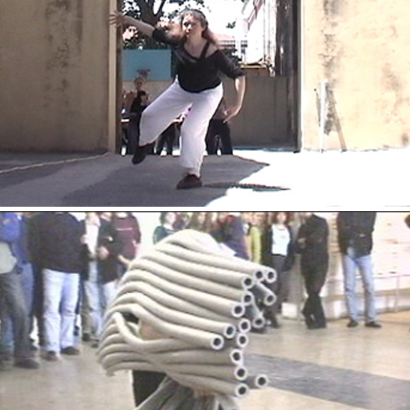
As far as I know, Aydin Teker is one of the most avant-garde choreographers in the world. She danced in a “costume-like object” made of vinyl pipes by us at my workshop.
私が知る限り、Aydin Tekerは世界で最もアバンギャルドな振付家の一人である。彼女は私のワークショップで、私たちがビニールパイプで作った「衣装のようなオブジェクト」を着てダンスしてくれた。
At one point I was surprised to see Aydin’s work. It was a performance by her students, at the start of the performance the students started dancing in the stepped aisle of the theater. The students were probably the first to experience it, and everyone I saw had their feet shaking. No one could go up and down the steps smoothly. Th e dance was strange because their legs and loins were unstable. This doesn’t happen on the stage. Everyone dances wonderfully because they are practicing. That’s not the case with unfamiliar experiences. However, in this “shaking” of the students, I could see the “individuality” of the students. This is because everyone has different ways of dealing with it. In the end, what impressed me was not the work on the stage, but the steps that made the students uneasy and the “individuality” they unintentionally showed. I thought Aydin’s interest must be in the relationship between space and body.
ある時、私はAydinの作品を見て驚いた。彼女の生徒たちによる公演だったが、生徒たちは開演と共に劇場のステップのある通路でダンスを始めた。生徒たちは、多分初めての体験だったのだろう、私が見た全員の足が小刻みに震えていた。誰もスムーズにステップの昇降が出来ない。足腰が不安定なのでダンスも変だ。舞台上ではこんな事は起きない。稽古を積んでいるので誰もが素晴らしくダンスする。慣れない体験ではそうは行かない。しかし、生徒たちのこの「震え」の中に私は生徒たちの「個性」を見る事が出来た。対処の仕方は皆違うからだ。結局、私の印象に残ったのは、舞台上の作品ではなく、生徒たちを不安にさせたステップと、彼らが思わず見せた「個性」だった。Aydinの関心は、空間と身体の関係にあるに違いないと私は考えた。
…………………………………
[2001]
[My Road / 私の道 <34>]
“My Istanbul / 私のイスタンブール”
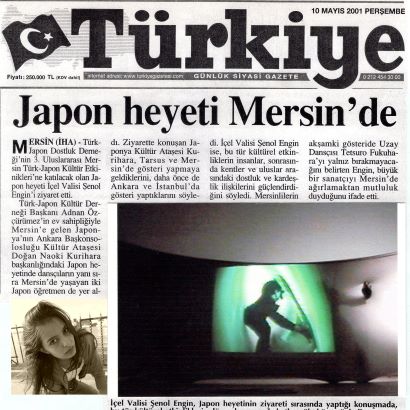
In 2001, I met Professor Ayden Teker at my performance at Mimar Sinan University in Istanbul produced by Japanese Embassy in Ankara. She was a well-known avant-garde choreographer in Turkey and soon I became friends with her. My best friend Yvonne said that cities that give a strong culture shock like Istanbul are rare and should go to me as well. When I came, I understood that it was true. From ancient times to the present, Istanbul has maintained its position as a big city with a mixture of East and West cultures. For the first time, when I was walking alone in the evening on the intricately complicated streets of so many slopes and stairs like a labyrinth, I was assailed by illusions that it was difficult to distinguish between ancient and medieval times and modern times. It was a mysterious feeling, for example, when I met an ancient ghost and a medieval ghost at the same time.
2001年、アンカラの日本大使館制作によるイスタンブールのミマール・シナン大学での私の公演で、アイデン・テケルに出会った。彼女は前衛的振付家としてトルコで有名な振付家で、すぐに仲良くなった。親友のイボンヌは、イスタンブールほどつよいカルチャーショックを与える都市は珍しく、私にも行くべきだと言っていた。来てみて、私はその通りだと実感した。イスタンブールは古来より現在まで東西文化が混交する大都市という地位を、守り続けている。初めての私も、夕方一人で坂道と階段のやたらに多い複雑に入り組んだ街並みを歩いていると、何やら古代や中世の時間と現代の区別がつかなくなるような幻覚に襲われた。それは、例えて言えば、古代の幽霊と中世の幽霊に同時に出会って驚くような不思議な感覚だった。
Since then, Istanbul has become my favorite city,I have come to go there every year as a base with my special classes and workshops at Mimar Sinan University by Ayden, Yldiz Technical University by Professor Gaywan introduced by Ayden, and a dance studio called CATI. And, I was surprised at many things, one of them was the beauty that the female dance students keep. I forgot what book I read, but I learned that today’s young women in Istanbul have four types of beauty, Arab, European, Russian, and Asian, as an ancient culturally mixed blood heritage. I also attached some of the pictures of the dancers who became my space dance workshop, and I actually felt that was exactly the case.
以来、イスタンブールは私の大のお気入りの都市となり、アイデンのミマール・シナン大学と、彼女に紹介されたゲイワン先生のイルディス工科大学と、CATIというダンススタジオの3ヶ所に、ワークショップの拠点として毎年行くようになった。そして、驚くことは多かったが、その内の一つが、女子学生たちが持つ美しさだった。何の本で読んだかは忘れたが、現在のイスタンブールの若い女性たちは、古来からの文化混交の血の遺産として、アラブ系・ヨーロッパ系・ロシア系・アジア系の4つの美の種類をもつという。私も、まさにそうだと実感できた。
The following are comments from Mr. Akio Wada, Consul General of the Consulate General in Istanbul, I could get the support from him in Istanbul.
以下は、在イスタンブール総領事館・総領事の和田章男によるコメントである。
”Space dance has the infinite potential of art to open up and develop new fields. I think that it has helped for Turkish people to break down the stereotypes knowledge about the Japanese people and understand that the modern Japanese are dynamic and cannot be grasped in a narrow and fixed way.”
「スペースダンスは、新しい分野を切り開いて発展していく芸術の無限の可能性を秘めたものでした。それは、トルコの人びとに対して、日本人に対する固定観念を打ち破り、現代の日本人は狭く固定的に捉えることが出来ないダイナミックな民族であることを理解して頂いたものと思います。」
…………………………………
[2001]
[My Road / 私の道 <33>]
“Space Dance in Headquarters United Nations in New York
/ スペースダンス in ニューヨーク国連本部”
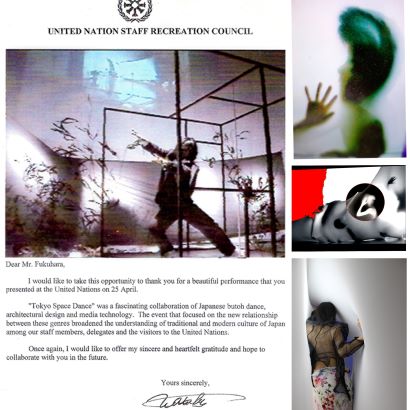
In 2001, Space Tube debuted overseas. I could get the opportunity to present the concept of Space Tube at the MIT Media Lab in Boston the previous year, and Space Dance performance using Space Tube was realized at the United Nations Headquarters in New York. After the performance, we also could hold “Kids Space Dance” with children who were interested in Space Tube among the visitors from all over the world. One great person from the United Nations told me that “this event would be one of the top five events held at the United Nations in history“, and I received the following comments.
2001年、スペースチューブの海外デビュー。前年にボストンのMITメディアラボでスペースチューブのコンセプトをプレゼンテーションする機会に恵まれ、その余勢でニューヨーク国連本部でのスペースチューブ使用のスペースダンス公演が実現した。日本の舞踏家による国連公演は私が最初だった。公演後、見学者たちの中でスペースチューブに興味をもった子供たちと「こども宇宙ダンス」を実施した。国連の偉い人より「国連で実施されたイベントの内、歴代ベスト5に入る」とおだてられ、以下のコメントを得た。
”I would like to take this opportunity to thank you for a beautiful performance that you presented at the United Nations on 25 April. Space Dance was a fascinating collaboration of Japanese Butoh dance, architectural design and media technology.”
「ニューヨーク国連本部で上演されたスペースダンスの美しい公演に対して、心からのお礼を申し上げます。スペースダンスは、日本の舞踏ダンスと建築とメディアテクノロジーによる真に魅惑的なコラボレーションでありました。」
…………………………………
[1999]
[My Road / 私の道 <32>]
“Design after Dance in Cranbrook College
/ ダンスの後にデザインが生まれる in クランブルック大学”
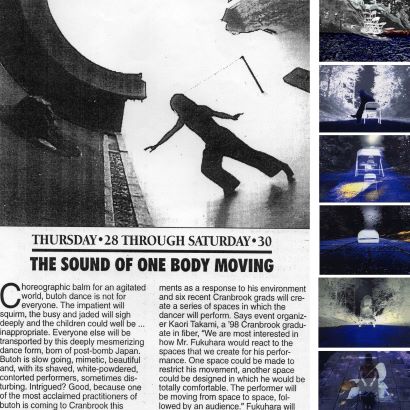
In 1999, I was invited to Cranbrook College in Detroit by the later Prix de Rome architect Professor Peter. Peter and his students created multiple architectural sites on campus for Space Dance Performance, costumes made by ceramics, and media students made music and video. It was a performance where I and tombo entered as Space dancer and danced while moving through the architectural sites. It was a practice of the concept that “prototype of various chairs” was born as a result of the performance, and “Design was born after Dance“.
1999年、後にローマ賞を受賞した建築家・ピーター教授に、デトロイトのクランブルック大学に招待された。ピーターと彼の学生たちがスペースダンス公演の為に構内に複数の建築的サイトをつくり、セラミックで衣装をつくり、メディア学科の学生たちが音楽と映像をつくった。そこに私とtomboがスペースダンサーとして入り、建築的サイトを移動しながらダンスしていくという公演だった。それは、公演の結果として「多様なイスの原形」が誕生し、「ダンスの後にデザインが生まれる」というコンセプトの実践だった。
…………………………………
[1998]
[My Road / 私の道<31>]
“SPACE DANCE – Body of Future / スペースダンス~身体の未来”
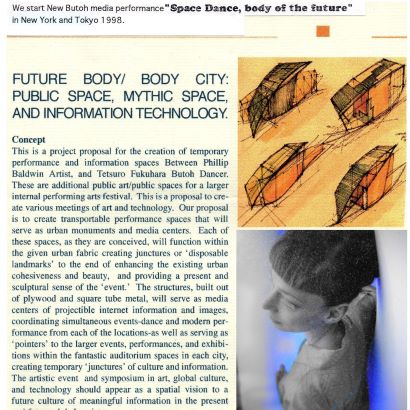
In 1998, I held a Space Dance and architecture workshop inspired by Space Tube together with stage artist and architect Pillip Baldwin at a big gallery in New York. Then, after a workshop, his friend media artist joined and I performed “SPACE DANCE – Body of Future” with them.
1998年、舞台美術家・建築家のフィリップ・バルドウィンと、ニューヨークの大ギャラリーで。スペースチューブをヒントとするスペースダンスと建築のワークショップを行い、その後、彼の友人のメディアアーティスも参加し、「スペースダンス~身体の未来」と題する公演を実施した。
…………………………………
[1998]
[My Road / 私の道 <30>]
“Birth of Space Tube / スペースチューブ誕生”
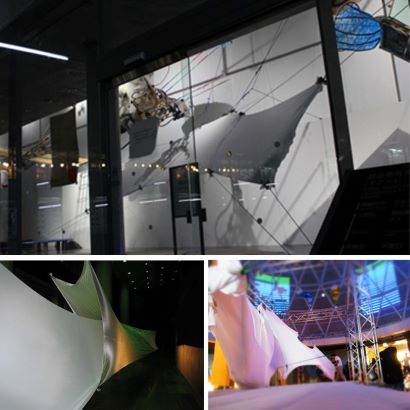
In 1998, when I was a part-time lecturer at Musashino Art University, Faculty of Architecture in Tokyo, the prototype of Space Tube was born from a special class called “Body and Architecture“. And while we are using it in our performances, the open space changed to a closed space, floating about 1 meter from the ground, and the material changed from a hard cloth to a special cloth that has the strength and softness to allow one person to hang in the air, and it was finally completed to transform as a space tube in its current form. It is a first memorable design achievement that fulfills the “Art-Industry Body Concept” owned by Tokyo Space Dance.
1998年、私が東京の武蔵野美術大学・建築学部で非常勤講師を務めていた時、「身体と建築」と名付けた特別授業からスペースチューブの原形が誕生した。そして、それを私たちが公演で使用している内に、開いた空間が閉じた空間に、地面に着いた状態から1メートルほど浮いた状態に、素材も硬い布から人一人を宙づりにできる強度をもちしかも柔らかさを備えた特別な布に、大きく変化し、最終的に現在の形態のスペースチューブとして完成した。東京スペースダンスが所有する、「芸術-産業体構想」を満たす記念すべき最初のデザイン成果である。
…………………………………
[1998]
[My Road / 私の道 <29>]
“Citta della Scienza in Napoli / ナポリ科学館”
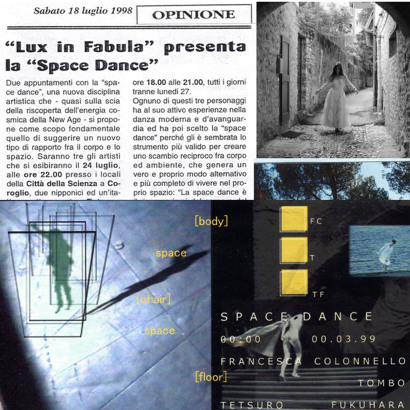
In 1998,Butoh was all the rage in Rome, and my workshop had 50 participants. I was so numerous that I couldn’t even remember their names. I became friends with Katerina Genta who graduated from a college class taught by Pina Bausch and Elena Rapka at the University of Rome, and I asked Elena and Katerina to work as my assistants. I have a memory that I managed to survive. The performance, which was held with tombo and two of them, and by selecting a few of the participants, was also a great success.
1998年、ローマでは舞踏が大流行していて、私のワークショップには50人の参加者があった。私は数が多すぎて彼らの名前も覚えられず、参加者の中でローマ大学のエレナ・ラプカとピナ・バウシュが教える大学を卒業したカテリーナ・ゲンタと親しくなり、彼女ら二人にも助手を務めてもらい、何とか乗り切った。tomboと彼女ら二人と、参加者の中から数名を選抜して実施した公演も、大成功だった。
In Napoli, together with tombo, Katerina, and Elena, I performed at a large science museum called “Citta della Scienza” using a device that can make music with dance moves. Then, after hearing from a friend that Elena was unknown after this event, I wanted her to continue to play an active role as an assistant, so I asked my friends and related sources. However, several years have passed without me knowing Elena’s whereabouts. At that time, I had a personal incident in which I had a strong trauma due to the death of my first love partner at the age of 17, which hindered my daily life, and Elena, who disappeared like a spirited away by a supernatural being, became a myth in me. Then, the images of Elena and my first love partner overlapped, and it became a symbol of my “Search for a Lost Lover” after that.
ナポリでは「Citta della Scienza」という大きな科学館で、tombo・カテリーナ・エレナと共に、ダンスの動きで音楽をつくる装置も使用して公演した。そして、このイベント後にエレナが消息不明になったと友人から聞き、その後も助手として活躍して欲しいと思っていたので、友人や関係筋に聞きまわった。しかし、エレナの消息が掴めないままに数年が過ぎた。当時、私には、17才の時の初恋の相手の死でトラウマを抱え日常生活に支障をきたすという個人的事件があり、神隠しのように消えてしまったエレナが私の中で神話化され、エレナと初恋の相手のイメージが重なった。エレナは、その後の私の「失われた恋人探し」のシンボルになった。
…………………………………
[1997]
[My Road / 私の道 <28>]
“Behavior in Virtual Space / 仮想空間における身ぶり”
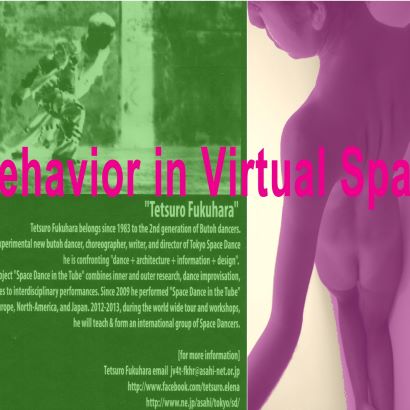
As a research fund project by the Ministry of Education, Culture, Sports, Science and Technology of Japan, in collaboration with media art curator Machiko Kusahara, “Behavior in Virtual Space” was held as a space dance performance at a large art gallery in New York in 1996. I used the latest technology to create a virtual space, but instead of using the dancer’s movements for the directing purpose of media artist, how do dancers want to use technology for their own dance? It attracted attention as a project that uses technology for dancer’s development.
1996年、日本の文部科学省研究費プロジェクトとして、メディアアートキュレーター・草原真知子と組み、ニューヨークの大ギャラリーで「仮想空間における身ぶり」をスペースダンス公演として実施した。仮想空間形成の為に最新のテクノロジーを使用したが、ダンサーの動きがメディアアーティストの演出目的の為に利用されるのではなく、ダンサーが自分のダンスの為にテクノロジーをどう使用したいのかという点に焦点を置いた為、ダンサーの発展の為のテクノロジーを使用している企画として注目された。
…………………………………
[1996]
[My Road / 私の道 <27>]
“Shusaku Arakawa × Masato Sasaki × Tetsuro Fukuhara
/ 荒川修作 × 佐々木正人 × 福原哲郎”
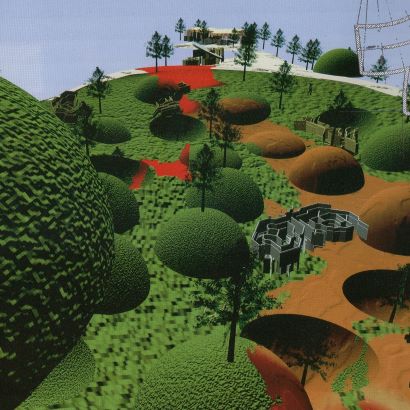
On Shusaku Arakawa special feature in the magazine of “Contemporary Thought“, a dialogue between Shusaku Arakawa, Masato Sasaki, and Tetsuro Fukuhara was realized. The theme that Arakawa pursues was “Immortality” and he asked me “in order to be immortal, we need to lose our body. what do you think?“, then I answered to him “No, it is not good idea because we need a body always when we are, when we die, and in the next word. The way for the immortality will open when we lift our body a little.” Our claims, such as Zen questions and answers, followed parallel lines, then Sasaki filled the gap from an affordance perspective.
雑誌・現代思想の荒川修作特集で、荒川修作・佐々木正人・私の3者対談が実現した。荒川が追及するテーマは「不死」で、私に対して「不死になる為には身体は無くなる必要がある。君はどう思うか?」と問いかけ、私は「そうではなく、身体は、生きている時も、死ぬ時も、次の世界でも、いつでも必要。不死は、身体を少し浮かすことからその道が開かれる」と答えていた。禅問答のような二人の主張は平行線を辿り、佐々木がそのすれ違いをアフォーダンスの観点から埋めてくれた。
Masato Sasaki is a cognitive psychologist, he has been paying attention to “Posture“. He wrote in his book “Where is the intelligence born?” by Kodansha publishing company in Tokyo that the posture is a network of relationships that incorporate multiple perceptual organs that are linked to the environment through the body. His thought is completely “physical“, so one day I asked to him its reason. He told me that he was a thread-manipulating puppeteer when he was young, so it was influenced by this experience. I was convinced, “I see!” The physical experience was directly linked to his research.
佐々木は著書『知性はどこに生まれるか』(講談社)の中で「姿勢とは、身体全体で環境とリンクする、知覚の器官を多重にとりこんだ関係のネットワークなのである」と書き、「姿勢」に注目してきた認知心理学者である。その考えは徹底的に「身体的」の為、ある日不思議に思った私はその理由を尋ねたことがある。彼は、若い頃に糸操りの人形師をやっていたのでその影響だと思うと教えてくれた。私は「なるほど!」と納得した。身体的体験が研究に直結していたのである。
…………………………………
[1996]
[My Road / 私の道 <26>]
“Body-Space Model with Affordance
/ アフォーダンスによる「身体-空間モデル」”
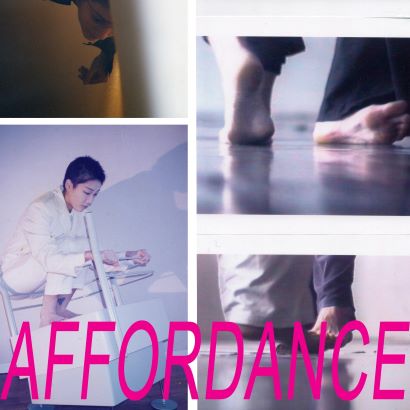
Around the same time, I met Masato Sasaki, a professor at the University of Tokyo who introduced “Affordance.” With him, at Tokyo University and the underground shopping center of Ikebukuro Station, his important blind assistant also participated in a workshop to experience how physical movements are generated depending on the environment, and this experience became another big factor for the birth of Space Dance.
同じ頃、アフォーダンス紹介者の東大教授・佐々木正人に出会った。佐々木とは、東大構内や池袋駅の地下街で、彼の重要な盲目の助手も参加して、いかに身体の動きが環境に依存して生成しているかを体感するワークショップをやり、この体験がスペースダンス誕生のもう一つの大きな機縁になった。
Affordance is a theory that has proved to me the correctness of Improvisation Butoh from an “Environmental” perspective. And above all, it gave me a lot of valuable hints for developing a “Body-Space Model“. “Body-Space Model” is still incomplete, but according to this model, it is easy to understand its all reasons, why is the current architectural space and industrial design inconvenient for the ever-changing human body?, why isn’t a robot really intimate with humans born?, why human remodeling by genome editing fails?, why is it a fundamental flaw in space development in the current world? Therefore, at the same time, I have to recognize that the “Body-Space Model” has a great role to play in the world.
アフォーダンスは、私には即興舞踏の正しさを「環境」の観点から証明してくれた理論である。そして、何よりも私が「身体-空間モデル」を構想する為に、実に貴重な多くのヒントを与えてくれた。「身体-空間モデル」はまだ未完成だが、しかしこのモデルに従えば、なぜ現在の建築空間や工業デザインは変貌を続ける人間の身体には不都合になるのか、なぜ人間に親密なロボットが誕生しないのか、なぜゲノム編集による人間改造は失敗するのか、なぜ現在の世界の宇宙開発には基本的欠陥があるのか、それらの理由がわかる。従って、同時に、私は「身体-空間モデル」が世界に対して果たすべき役割が大きいことを実感している。
…………………………………
[1996]
[My Road / 私の道 <25>]
“Space Dance in Shusaku Arakawa’s Ryoanji Temple in Nagi
/ スペースダンス in 荒川修作の奈義の龍安寺”
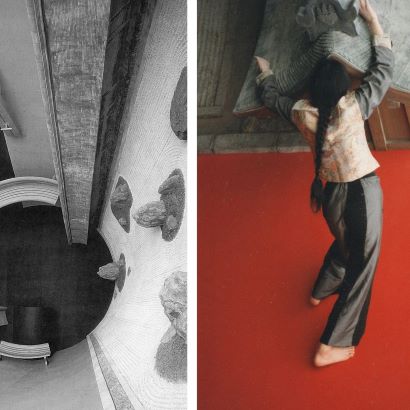
In 1996, after from Beirut, I met Shusaku Arakawa. I and newly my partner tombo danced at “Ryoanji Temple in Nagi” in Okayama, Japan, and this experience became one of the major reasons for the “Birth of Space Dance.”
1996年、ベイルートから帰国後に荒川修作に出会った。彼の岡山にある「奈義の龍安寺」で新しく私のパートナーになったtomboと共にダンスし、この体験がスペースダンス誕生の大きな機縁の一つになった。
Shusaku Arakawa started as a contemporary artist living in New York, and eventually came to call himself a new generation architect. He was a heretic who aimed for a revolution from architecture by proposing “architectural space formed from curved surfaces” to the world’s architectural world, which continues to be sluggish for a long time while seeking a leap from modern architecture. I couldn’t agree with his idea to the body, but I thought his gaze on the relationship between body and space was wonderful. And above all, I was greatly inspired by his question, “If nothing is born after the dance, maybe we feel the emptiness?“
荒川修作はニューヨーク在住の現代美術家として出発し、最後には新世代建築家を名乗るようになっていた。近代建築からの飛躍を求めながらも長く低迷を続ける世界の建築界に対して「曲面から成立する建築空間」を提案し、建築革命を目指した異端児である。私は荒川の身体に対する主張には賛同できなかったが、彼の身体と空間の関係に対する視線は素晴らしいと思った。そして、何よりも彼の問い「ダンスの後に何も誕生していないと、虚しいのでは?」に私は大きな霊感を受けた。
…………………………………
[1996]
[My Road / 私の道 <24>]
“I was a Star / 私はスターだった”
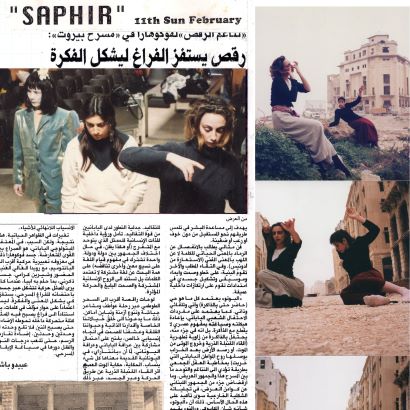
The performances and workshops in Beirut were initially only scheduled for and college produced by Ru-eida Gari. That was Japanese embassy staff who took care of me, so in a good meaning I was used by him, performing at American University and Islamic Memorial, and every day I was planning to stay for 10 days became a job. It was widely introduced on TV and newspapers, and I was treated as a star, and many audiences, including government officials, rushed in. That’s because the civil war has just ended in Lebanon, many abandoned buildings remain in Beirut, and many countries from Europe are already in support, but from Asia, there was none. So he took me to many places and made me the first visitor from Japan. I’ve heard that Japanese diplomats are excellent abroad, and he seems to have been one of them.
ベイルートの公演とワークショップは、最初はルエイダ・ガリが制作してくれた劇場と大学での予定だけだった。それが、私に対する世話役として入った日本大使館員がやり手だった為、いい意味で私は彼に利用され、アメリカン大学やイスラム記念館でも公演し、10日間の滞在予定の連日が仕事になった。TVや新聞でも大きく紹介され、私はスター扱いになり、政府の要人を含め多くの観客が押し掛けた。それというのも、レバノンでは内戦が終了したばかりで、ベイルートでは多くの廃墟になったビルが残されたままで、ヨーロッパからは既に多くの国が支援に入っているにも拘わらず、アジアからは皆無だった。そこで、彼は私をいろんな所に引き連れ、日本からの最初の訪問者に仕立て上げたわけだ。日本の外交官は海外では優秀という話しは聞いていたが、彼は正にその一人だったようだ。
Lu-eida was a participant in a workshop I held in Paris and not only had a beautiful dance, but also had a kind of strong emotion that I didn’t know, maybe it was unique to the Middle East. In 1994 I invited her to Japan and in return she invited me to Beirut.
ルエイダは私がパリで実施したワークショップの参加者で、美しいダンスをするだけではなく、中東に特有なのか、私が知らない種類のつよい感情を持っていた。1994年に私が日本に彼女を招待し、お返しとして私がベイルートに招待された。
…………………………………
[1996]
[My Road / 私の道 <23>]
“Beirut-Wake up to “What is information?”
/ ベイルート~「情報とは何か?」に目覚める”
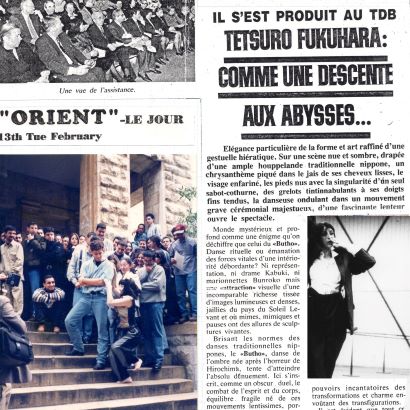
In my case, it was through the 1996 Beirut experience that I felt truly awakened to “information.” There, I got the information, “There are 10,000 jobs in Beirut. Does anyone come?” Of course, such information was not available in Japan. Usually, symbolically, 1,000 artists rush to the world’s cultural cities of Paris, London, Berlin and New York every year, and only about 10 pass. 990 people are disappointed and return home. However, as Beirut is called “Little Paris,” many young people speak French and English, have a high level of culture, are active in art, and have a strong criticism. If the purpose is not to become famous, but to do the work we want to do, 10,000 employment will be a big charm.
私の場合、「情報」に真に目覚めたと思えるのは、1996年のベイルート体験を通してである。そこで私は、「ベイルートにアーティストへの1万の雇用あり。誰か来ません?」という情報を得た。そんな情報は、もちろん日本では得られなかった。通常、象徴的に言うと、毎年1000人のアーティストが世界の文化都市パリ・ロンドン・ベルリン・ニューヨークに押しかけ、合格するのは10人程度。990人は失望し帰国する。しかし、ベイルートは「小さなパリ」と呼ばれているように、若者はフランス語と英語を話す者が多く、文化レベルは高く、アートも盛んで、批評精神も旺盛である。目的が有名になる事ではなく、自分がやりたい仕事をやる事なら、1万の雇用は大きな魅力だろう。
In Beirut, I learned that even though the internet is full of almost infinite information, it is almost same information that comes from a limited perspective. Regarding Beirut, only one aspect of being a politically and economically confused city is emphasized, and the actual situation is unknown. And what if there are more and more such cities around the world now?
私はベイルートで、ネットにはほとんど無限の情報が溢れているといっても、それは限られた視点から発信された同じような情報ばかりである事を知った。ベイルートについては、政治的にも経済的にも混乱した都市という一面だけをジャーナリズムは強調し、文化は豊かである事、人々はどんな思いで毎日を生きているか、その実情は知られていない。そして、いま、このような都市が世界中でどんどん増えているとすれば?
…………………………………
[1995]
[My Road / 私の道 <22>]
“east winds festival of new butoh”
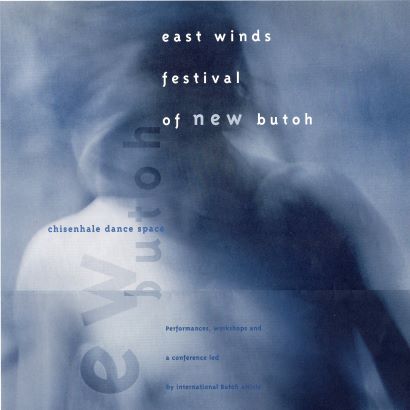
In London. I joined “east winds festival of new butoh.” The Sunday Times was criticized as a “Moving Sculpture” because my dance movements were too slow. I could enjoy this slow time to the fullest. Because, at that time I was seeing that my movement was slow from the outside and same time one world was suddenly occurring inside me while spinning rapidly, then I was surprised at the difference itself between outside and inside.
ロンドンで。「east winds festival of new butoh」に参加した。The Sunday Timesには、私のダンスの動きがあまりにもスローだったので「動く彫刻」と批評された。私はこのスローな時間を存分に楽しんだ。というのも、その時私は外部から見ると私の動きはスローなのに私の内部では一つの世界が急回転しつつ新しく発生している光景を見ており、外部と内部の差があまりにも大きい事自体に驚いていたからである。
…………………………………
[1994]
[My Road / 私の道 <21>]
“Passage Festival 94 at Kiyomizu Temple – Joujuin
/ パサージュフェスティバル94 清水寺・成就院”

50 panels borrowed from Sekisui House by Keiichi Irie(architect) to create a large-scale “Bridge” inside and outside of Kiyomizu Temple – Joujuin in Kyoto, and 26 TV monitors borrowed from SONY by Andrea Schneider(media artist) to create “Light“. A total of 20 dancers, including me and participants from overseas, danced there.
建築家・入江経一が積水ハウスから借りた50枚のパネルで京都の清水寺・成就院の室内と外に大規模な「橋がかり」をつくり、アンドレア・シュナイダー(メディアアーティスト)がソニーから借りた26台のTVモニターで「照明」をつくり、そこで私や海外からの参加者を含め総勢20人のダンサーがダンスした。
Female dancers from overseas are particularly interested in Joujuin’s high-ceiling kitchen that has become a colonnade. And, the wife of President Kiyomizu Temple has the same open mind as him, and usually the mother will hide the scene when female dancers dance with naked body to an elementary school student, but she said to her son that it is a “good opportunity to take a closer look at the naked woman, see it’s details carefully.” Kyoto is a special city with a subtimle mix of conservative and innovative spirits.
海外の女性ダンサーたちは、成就院の吹き抜けになった高い天井の台所に特別に興味を示した。また清水寺管長の奥さんは、このイベントを開催してくれた管長と同じく開放的な心の持ち主で、ふつうなら女性ダンサーたちが裸で踊るシーンは小学生の息子には隠すところを、「いい機会だから女の裸をよく見ておきなさい」と勧めていた。京都は、保守と革新の精神が微妙に入り混じる特別な都市なのである。
…………………………………
[1994]
[My Road / 私の道 <20>]
“Passage Festival 94 / パサージュフェスティバル94”
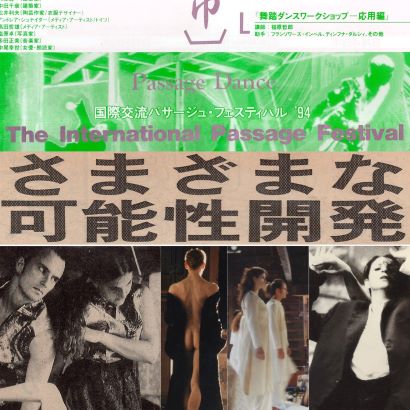
In the summer of 1994, I held “Passage Festival 94” in Tokyo, Kiryu, Kyoto, Paris, and Cardiff with the participation of 14 dancers from overseas, and in Japan, Yasuo Ito, Hajime Yatsuka, Seiichi Washida(mode criticism), Junichi Arai(textile planner), Masaaki Sakaguchi(fashion designer), Keiichi Irie(architect), and Andrea Schneider(media artist) and others.In Kiryu I tried to embody the “Art-Industry Body Concept” in collaboration with the local industry “Cloth“. Every day, the articles by Kiryu Times was published.
1994年・夏、海外から14名のダンサーを招待し、国内では伊藤裕夫・八束はじめ・鷲田清一(モード批評)・新井淳一(テキスタイルプランナー)・坂口昌章(ファッションデザイナー)・入江経一(建築家)・アンドレアシュナイダー(メディアアーティスト)らの参加を得て、東京・桐生・京都・パリ・カーディフで『パサージュフェスティバル94』を開催した。桐生では、地場産業の「布」と組み「芸術-産業体構想」の具体化を試みた。連日、桐生タイムスによる大きな記事が出た。
With the support, sponsorship and cooperation of the Japan Foundation, British Council, French Embassy, NHK, Asahi Beer, Shiseido, Sekisui House, Mainichi Newspapers, Wacoal, Sony, Kiyomizu Temple, Kyoto College of Art, Paris 8th University, it was a valuable and large-scale event that presented the development process of Tokyo Space Dance.
国際交流基金・ブリティッシュ カウンシル・フランス大使館・NHK・アサヒビール・資生堂・積水ハウス・毎日新聞社・ワコール・ソニー・清水寺・京都芸術短期大学・パリ第8大学などの後援・協賛・協力を得た、東京スペースダンスの発展過程を提示する、予算も大きく、とても大掛かりなイベントになった。
…………………………………
[1994]
[My Road / 私の道 <19>]
“Future of Wild Nature 4 – What Tatsumi Hijikata couldn’t leave
/ 野生の未来4~土方巽が残せなかったもの”
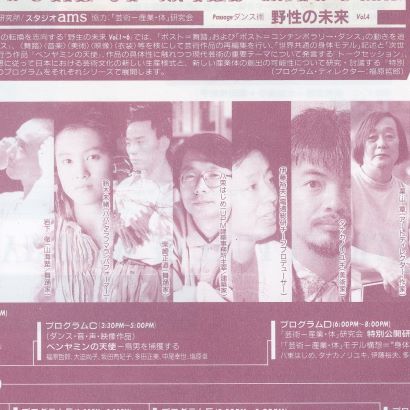
In 2004, I held “Future of Wild Nature 4 – What Tatsumi Hijikata couldn’t leave” in Tokyo and the following criticism was posted by Shou Kuriyama, Japanese critic in New York, in the evening edition of Yomiuri Newspaper.
1994年、私は「野生の未来4」を東京で開催し、読売新聞夕刊には、ニューヨーク在住の批評家・栗山章による次の批評が掲載された。
”Beyond Tatsumi Hijikata. Tetsuro Fukuhara of improvisational Butoh plans a heated debate on the theme of “What Tatsumi Hijikata couldn’t leave” with young talents in various fields such as theatrical performer Satoshi Miyagi, Papatara Fumara Hiroshi Koike, and Sankai Juku Toru Iwashita. In the field of Butoh, the only cutting-edge entertainment that happened in Japan after the war, there is finally to start the rasing problem that is under a taboo, toward a new development that cuts off the retreat”.
「土方巽を超えて。即興舞踏の福原哲郎は、<土方巽が残せなかったもの>をテーマに、演劇人・宮城聡、パパタラフマラ・小池博史、山海塾・岩下徹など多様な分野の若い才能をむかえた激論を企画している。戦後日本におこった唯一の、といえるこの先鋭の芸能の、うしろ髪を絶つあらたな展開にむけて、タブーにひとしかった問題提起がようやく端緒につこうとしている」。
…………………………………
[1992]
[My Road / 私の道 <18>]
“Wind from the Future 4 – Standing ZEN
/ 未来からの風4~立ち上がる禅”
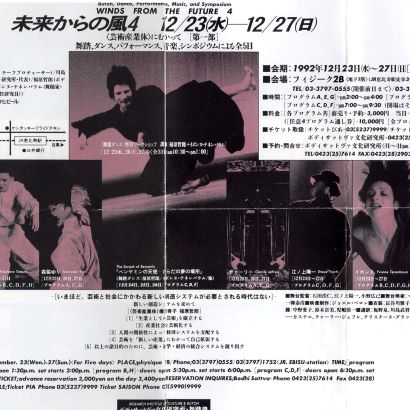
In 1992, “Wind from the Future 4” was held supported by Asahi Newspaper, with Kazuo Ohno as a special guest, Yvonne Tenenbaum who says “Butoh is a Standing ZEN” from Paris, and young talented people such as Toru Iwashita, Satoshi Miyagi and Kaho Kanzo in Japan. The following newspaper article by Kyodo News was published as a critique of the previous “Wind from the Future 3”.
1992年、朝日新聞社後援で開催した『未来からの風4』では、大野一雄を特別ゲストに迎え、パリから舞踏を「立ち上がる禅」と批評するイボンヌ・テネンバウムを招き、国内では岩下徹・宮城聡・神蔵香保らの若手の才能を招いた。前回の「未来からの風3」に対する批評として、共同通信社による以下の新聞記事が掲載された。
”It was Tetsuro Fukuhara who became the subject of this event. He is known as one of the few dancers who can physically submit the sharpest awareness of the problem. It was five days when Kazuo Ohno and Takaaki Yoshimoto appeared, and the Butoh dancer Fukuhara struggled to have words (philosophy) independent of Butoh”.
「この催しの主体になったのは福原哲郎である。福原は、いま最もシャープな問題意識を肉体をもって提出できる、数少ない踊り手の一人として知られている。大野一雄や吉本隆明が登場し、舞踏家が、舞踏と独立した言葉(思想)を持とうとして格闘した五日間であった」。
I was taken care of by Yvonne in Paris, but the philosopher and butoh critic she was also a contemporary dancer and was interrupted due to a hip injury. Through the encounter with me, she found that she could continue her dance according to Improvisation Butoh, so she not only talked to Kazuo Ohno at this event, but also revived her dream as a dancer.
イボンヌにはパリでお世話になっていたが、哲学者・舞踏評論家の彼女は以前コンテンポラリーダンサーでもあり、腰のケガのために中断していた。それが私との出会いを通じ、即興舞踏によれば自分のダンスを継続できることがわかり、このイベントで大野一雄と対談するだけではなく、ダンサーとしての夢の復活も果たした。
…………………………………
[1991]
[My Road / 私の道<17>]
“Wind from the Future 3 – Art-Industrial Body Concept
/ 未来からの風3~芸術-産業体構想”
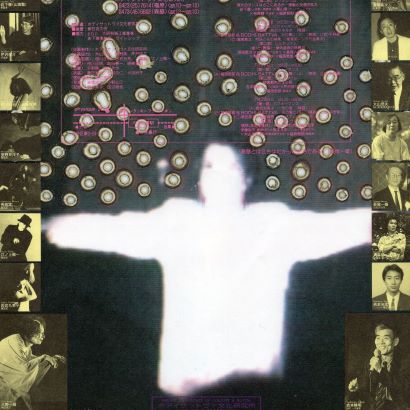
In 1991, “Wind from the Future 3” was held with the support of Asahi Shimbun in Tokyo, with Kazuo Ohno and Takaaki Yoshimoto as special guests, and a five-day performance and symposium was held. On the final day, together with Yasuo Ito and Shigeo Oyama, we discussed about “Art-Industrial Body Concept“.
1991年、朝日新聞社後援で東京で開催した『未来からの風3』では、大野一雄・吉本隆明を特別ゲストに迎え、5日間の日程で公演とシンポジウムを開催し、最終日には伊藤裕夫・大山茂夫と共に「芸術-産業体構想」について議論した。
Regarding my relationship with Dentsu Institute’s producer,Yasuo Ito, who was the secretary general of the Association for Corporate Support of the Mesena, said at the symposium at the time of its launch “I was skeptical about the ideal form of art that requires support from companies.” I was attracted to his this remarks and went to see him. From there the relationship began. Also,Shigeo Oyama of the Asahi News Paper Research Laboratory took great care of me and provided support during the event for the past few years.
電通総研のプロデューサー・伊藤裕夫との関係は、メセナ協議会事務局長という要職を務めていた彼が、その立ち上げ時のシンポジウムで「企業からの支援を必要とするアートの在り方に疑問を感じつつ進んできたのですが・・」との発言に惹かれ、会いに行ったところから始まった。朝日新聞調査研究室の大山茂夫にも大変お世話になり、この数年のイベント開催時のサポートをしてもらった。
I talked with Yasuo Ito, and with the participation of architect Hajime Yatsuka, we launched the “Art-Industry Body Concept”. This is an attempt to improve the status of art with the fundamental reform, which is still regarded as a “Shady Business” in Japan, by creating “Tomorrow’s Industry” through the collaboration between art and industry.
伊藤裕夫とは話しが進み、建築家・八束はじめにも参加してもらい、「芸術-産業体構想」を立上げた。これは、アートと産業の協働による「明日の産業」を誕生させることで、まだ日本では「虚業」という位置づけに甘んじているアートに対する根本的改革と地位向上の試みである。
…………………………………
[1991]
[My Road / 私の道 <16>]
“Wind from the Future 2 – with Takaaki Yoshimoto
/ 未来からの風2~吉本隆明と”
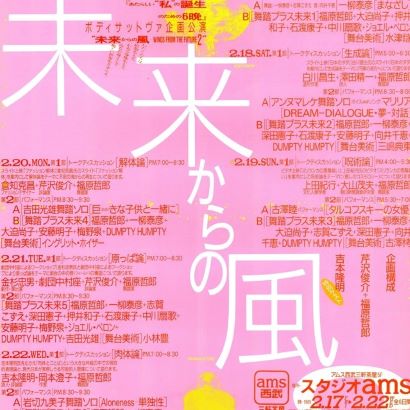
In 1989, at “Wind from the Future 2” held with the support of Asahi Newspaper in Tokyo, I talked with Takaaki Yoshimoto on the theme of “Physical Theory” and discussed about Tatsumi Hijikata’s Butoh.
1989年、朝日新聞社後援で東京で開催した『未来からの風2』では、私は吉本隆明と『肉体論』のテーマで対談し、土方巽の舞踏について議論した。
What is the reason Butoh has declined in Japan? After this time I had been in the very sarcastic cultural phenomenon, nor other Japanese Butoh Choreographers. Because, although I could get a high valuation in foreign cities, but I should lost my name year by year in Japan. Why? Butoh was born in Japan and I am Japanese.
土方巽の死以降、舞踏は海外で生き延びたが、国内で舞踏が衰退した理由は何だったのか? 私は、海外で活躍する他の舞踏家たちと同様に、海外では評価されても、舞踏を生み出した日本では無名になっていくという皮肉な文化現象を生きることになった。なぜなのか? 舞踏は日本で生まれ、私は日本人なのに。
I thought I should find out its reason exactly to develop Butoh and to continue my career as a Butoh Choreographer. So, at first I left the colleagues who didn’t want to recognize “Atrophy of Butoh” in Japan. Then, I asked to Takaaki Yoshimoto, very excellent critic at that time, and I could discuss with him about its reason at a symposium in Tokyo. Yoshimoto, very clearly, explained its reason as “Hijikata’s Body-Model was not a model which could reach to a Japanese Original Body in the era of KOJIKI, records of ancient matters.” I could understand his explanation and I had the scales fall from my eyes, because I had a big question to Hijikata’s “Butoh Notation.”
私は、舞踏家を続けるためには「国内で舞踏が衰退した理由」を正確に究明しておく必要があると考えた。それで、舞踏の衰退を認めようとしない批評家たちや舞踏グループからは離れ、当時日本の知性を代表する評論家として高く評価されていた吉本隆明を訪ね、このテーマを巡りシンポジウムで対談した。吉本は、端的に、「土方が採用した身体モデルは、古事記のように、日本人の原形の身体にまで遡及できるモデルになっていなかった」と指摘した。土方が残した「舞踏譜」に疑問を感じていた私は、この吉本の批評を目から鱗が落ちる思いで理解した。
In other words, Hijikata’s body-model was an “Artificial Model” at his time, not “Universal Model” that will be familiar to all Japanese beyond the generation. Young Butoh dancers were ungraceful on the stage in his last performance “Plan of Tohoku-Kabuki“, but it was not their responsibility. Just Hijikata’s body-model was a limited model that was familiar to only his generation.
つまり、土方の身体モデルは人工的なもので、あらゆる日本人に適用できる「普遍的モデル」ではなかった。土方の最後の公演『東北歌舞伎計画』で若い世代のダンスが無様だったのは、彼女たちの責任ではない。土方の身体モデルが、土方の時代にしか通用しない特殊モデルだったからだ。
…………………………………
[1990]
My Road / 私の道[ <15>]
“Tree of Tarkovsky in Paris / タルコフスキーの木 in パリ”
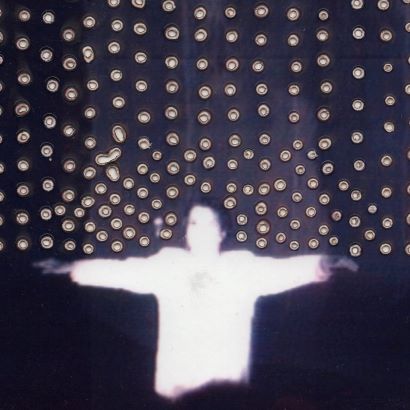
At the time of my first Butoh Performance in Paris on 1990, at the interview in radio broadcasting station, I was showered a carping question like a leadoff punch from a bitter woman announcer like the below;
1990年の私の最初の海外公演では、パリのラジオ局でのインタビューで、辛辣な感じの女性アナウンサーから先制パンチのような次の質問を受けた。
”We know already Butoh was consumed, then Butoh died. In our Paris, can you present something new as a Butoh Choreographer?“
「舞踏は既に消費され、死んだはず。このパリで、あなたが舞踏家として新しく提示できるものは何ですか?」
I knew the background of the introduction of Butoh in overseas including Paris, so I replied that it was “Butoh with Darkness” being consumed and still “Improvisation Butoh” remained. In truth, “Improvisation Butoh” was not introduced on a full scale. So I presented my thinking about “Improvisation Butoh” and explained that it keeps the possibility to open a new dance world that can not be caught up in Japanese Butoh to her. I felt easy because I could confirmed that she was listening my talk with her admirable face as her first experience. At that day, if I couldn’t answer to her with a confidence, sure I will be crushed. Then, night of the day, I could meet with Yvonne Tenembaum who heard my speeking in radio. She also had been pursuing “Butoh with Darkness” as a Butoh critic, but after seeing my Butoh she told me that she actually felt that “Butoh is still alive” as a late date.
私はパリを含めた海外都市での舞踏紹介の経緯は知っていたので、「消費されたのは暗黒舞踏であり、まだ即興舞踏が残っている」と答えた。実際、即興舞踏は本格的には知られていなかった。私は自分の舞踏についての考えを述べ、即興舞踏が日本人の舞踏に捕われない新しいダンスの地平を開く可能性があると説き、アナウンサーがそれははじめて聞く話しだという顔で感心している様子を確認し、安心した。あの日、私が自信をもって答えていなければ、私はつぶれていただろう。そして、その日の夜、私のラジオ放送を聞いて私のダンスを見に来たというイボンヌ・テネンバウムに出会った。イボンヌも、それまで舞踏批評家として暗黒舞踏を追いかけていたが、私のダンスを見て「舞踏はまだ生きている」と実感したと、後日教えてくれた。
I know an “Encounter” is such a thing. The meeting with Yvonne decided my way. I still remember clearly, including the details of my movements, what kind of magical dance happened at that night when Yvonne saw as the audience. Also at that time I could study that we can trust the European critique including a last radio announcer, because sometimes it is too hard with a bitter taste but it don’t have the lies. In Paris I could gain a confidence as a Butoh choreographer and my way was created.
「出会い」とは、こういうものなのだろう。イボンヌとの出会いが、その後の私を決定した。イボンヌが観客として見てくれたあの夜の私のダンスに、一体どんな印象的な動きが生まれたのか。その動きの細部も含め、今でも鮮明に覚えている。あのラジオのアナウンサーも含め、海外の批評は、辛辣すぎる程だが、嘘はないので信頼できることもこの時に学んだ。この点は日本の批評とは大きく違う。私はパリで自信をつけ、その後の私の海外を中心とする出発の形がつくられた。
…………………………………
[1990]
[My Road / 私の道 <14>]
“Butoh with Darkness and Improvisation Butoh / 暗黒舞踏と即興舞踏”
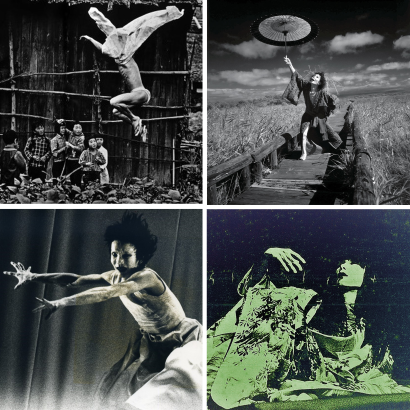
Turkish writer Orhan Pamuk who received the Nobel Prize for literature in 2006, wrote an interesting critic about a special possibility of Japanese Culture at a preface of Japanese version of his book “My Name is Red” such as “In China and in Japan they could keep the strong traditions of painting towards European painting. Moreover, under the influence of European painting, Japan could produce a very characteristic new art named Modern Painting.”
2006年にノーベル文学賞を受賞したトルコの作家オルハン・パムクは、日本文化がもつ独特な可能性について彼の小説『わたしの名は紅』の日本語版序文において、「中国や日本には西洋画に対抗できるつよい絵画の伝統があった。しかも、日本は西洋画の影響を受けつつ、日本独自の新しい近代絵画を生み出した」との趣旨を書いていた。
Butoh have same history like Japanese Modern Painting which Orhan appreciated its value. In the second half of 1950 in Japan, Tatsumi Hijikata and Kazuo Ohno could create “Butoh with Darkness” to unify Japanese traditional physical behavior before Edo-era and Modern Dance by Rudolf Lavin also Melii Wigman that Japan imported from German, Then, Akira Kasai could create “Improvisation Butoh” through “Butoh with Darkness.” In short, Butoh was not an original art, it was recreated by the Japanese taste on the imports from abroad.
舞踏もまた、オルハンが評価する近代絵画と同様である。舞踏は、1950年代末の日本で、江戸時代までに存在していた日本人の伝統的身体所作とルドルフ・ラバンやメリイ・ヴィグマンの表現主義舞踊などの現代ダンスを融合するものとして、土方巽と大野一雄が「暗黒舞踏」を創造した。そこから更に土方の片腕の一人だった笠井叡が「即興舞踏」を創造した。舞踏は日本国内で大きな力を持ったが、輸入品に日本的味付けをして再創造したダンスであり、近代絵画と同じく日本のオリジナルではないのである。
…………………………………
[1989]
[My Road / 私の道 <13>]
“I am Thinking / 私は考えている”
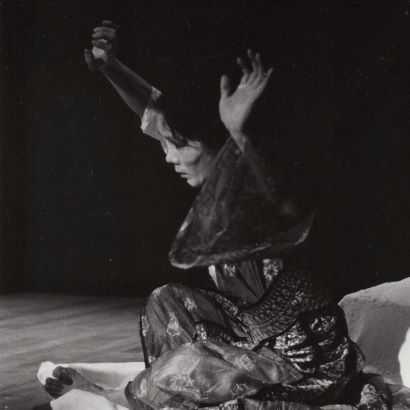
I started to think a lot. What is dance? Why do humans dance? Why did I also dance? Why dance is essential for me still now? The question closely related to life is why I can’t eat in dance? Particularly in Japan?
私はいろいろ考えるようになった。ダンスとは何か? 人間はなぜダンスするのか? なぜ私もダンスするようになったのか? なぜダンスは今も私に必須なのか? 生活に密接する問いとしては、なぜダンスでは食べられないのか? 特に日本では?
…………………………………
[1988]
[My Road / 私の道 <12>]
“Summer-Winds from the Future / 夏-未来からの風”
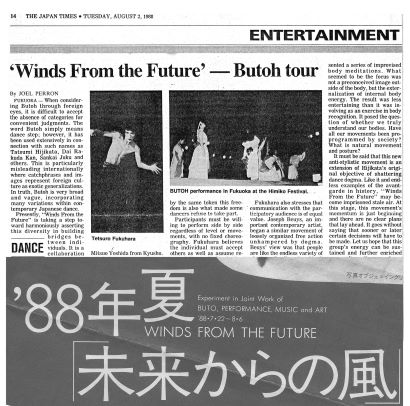
In 1988, I embarked on a Butoh trip with the members. Fukuoka → Yamaguchi → Okayama → Kobe → Osaka, and Kyoto. Butoh was popular all over Japan, so many audiences come in the venues. A reporter from The Japan Times accompanied me to an article about the situation. This article made our activity known to the society.
私はメンバーと共に舞踏の旅に出た、福岡→山口→岡山→神戸→大阪、そして京都へ。舞踏は日本中で流行していたので、多くの観客が会場に詰めかけた。その様子を、Japan Timesの記者が同行し記事にしてくれた。この記事により私たちの活動が世間でも知られるようになった。
…………………………………
[1987]
[My Road / 私の道 <11>]
“Dropping Out as Transparent Body / 透体脱落“
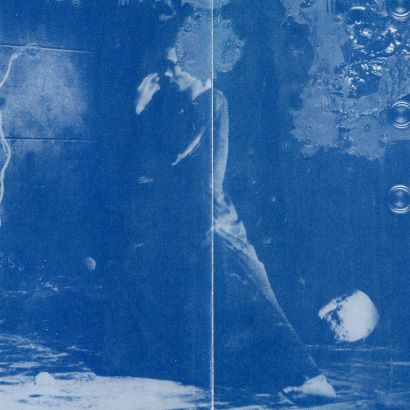
In 1987, I met famous Toru Terada, a literary critic and researcher of Kukai. He wrote that “I was impressed. I thought that your Butoh was a primordial movement in the shape of a bird” on the pamphlet of my performance. He also taught me the super wonderful word “Dropping out as Transparent Body“. At that time, philosophers and writers were still influential in society, and he also had an unique feeling, so his words made a deep impression on me.
1987年、有名な空海研究者で文芸評論家の寺田透と出会い、「感銘を受けました。あなたの舞踏は鳥の姿をとった生の原初の動きだと思へました」という文章を公演のパンフレットに書いてもらった。「透体脱落」という超・素敵な言葉も彼に教えてもらった。当時はまだ哲学者や文学者が社会の中で力をもっていて、彼にも独特な雰囲気があり、その言葉は私の心と身に染みた。
…………………………………
[1984]
[My Road / 私の道 <10>]
“Seven Plants Story / 七草物語”
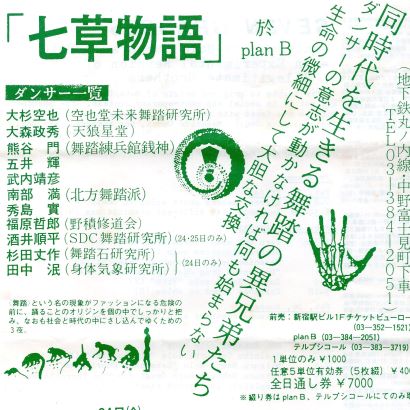
In 1984, I participated in “Seven Plants Story” supervised by Tatsumi Hijikata. This was an event attended by male dancers of the 2nd and 3rd generation of Butoh. I still remember how painful it was as a performance that I couldn’t get into my dance. The more I struggled on the stage, the more I felt like I was stuck in a swamp, and my body turned to stone and I couldn’t move. However, I was surprised to hear that my dance was highly evaluated at a critic meeting in which overseas critics including Hijikata participated. Certainly, in Butoh, the appearance of suffering decently can be touching in heart, so it may have been an example.
1984年、土方巽が監修した『七草物語』に参加した。これは舞踏の第2世代や第3世代の男の舞踏家たちが参加したイベントだった。私は自分のダンスに入ることが出来なかった公演として、とても苦しかったことを今でもよく覚えている。舞台上でもがけばもがくほど泥沼にはまり込む感じで、身体が金縛りに合い、身動きできなくなっていた。ところが、土方を含む海外の批評家たちも参加した批評会で、私のダンスが高く評価されたことを知り驚いた。確かに、舞踏ではまともに苦しむ姿が感動を呼ぶことがあるので、その一例だったのかも知れない。
…………………………………
[1980]
[My Road / 私の道 <9>]
“Water Wing / 水の翼”
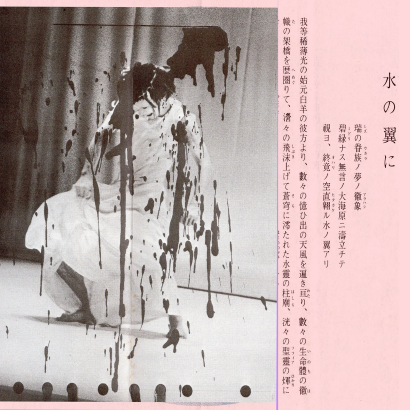
From some time ago, I started writing long poems on performance pamphlets. I was also influenced by Hölderlin and Nijinsky’s books. Why do I need such a thing in the Butoh performance pamphlet? I knew it was unnecessary, but I couldn’t stop writing. Later, when I visited Tatsumi Hijikata in his later years, Hijikata took out a bunch of pamphlets from his study and showed them to me, and asking, “This is all you, right?” “To Water Wing” was one of them. When I looked at it, there were red lines here and there by him. Then he asked, “Why do you need words as a Butoh dancer?” This is a question what I wanted people to ask the most.
私はいつの頃からか、公演のパンフレットに長文の詩を書くようになっていた。ヘルダーリンやニジンスキーの本にも影響された。舞踏公演のパンフレットになぜそんなものが必要なのか。不必要とわかっていたが、書かずにはいられなかった。後日、晩年の土方巽を訪ねた時、土方は一束のパンフレットを書斎から持ち出して私に見せ、「これ、全部あなたのですよね?」と聞いた。土方が私の文を保存していたのだ。なぜ? 「水の翼に」はその中の一つ。見ると、あちこちに赤線が引いてあった。そして土方に「なぜ、舞踏家に言葉が必要なのか?」と聞かれた。それは私が人に一番質問して欲しい質問だった。
…………………………………
[1976]
[My Road / 私の道 <8>]
“Spirit / 心意気”

This is one of my favorite photos. I feel the “Spirit.” In November 1970, at the time of the university struggle, I was staying in a classroom of my university occupied by our team in a local city for the sixth year of my enrollment. At midnight, news of Yukio Mishima’s seppuku suicide was broadcast on TV. I suddenly thought that I needed to go to Tokyo and study Butoh. At that time, I was also doing theater, but I intuitively felt that this road was “It.”
私が好きな写真の一枚。「心意気」を感じるから。1970年11月、当時は大学闘争の時代で、私は在籍6年目の地方都市の大学の占拠した教室に泊まり込んでいた。深夜、TVで三島由紀夫の割腹自殺のニュースが流れた。その時私はなぜか突然、東京に行き舞踏を学ぶ必要があると思った。当時は演劇もやっていたが、直観的に「この道が<それ>だ」と感じたからだ。そして、こんな時に何よりも必要と感じたのが「心意気」だった。それが無ければとても「前」に進めないからだ。
…………………………………
[1976]
[My Road / 私の道 <7>]
“Mind and Form / 心と形”
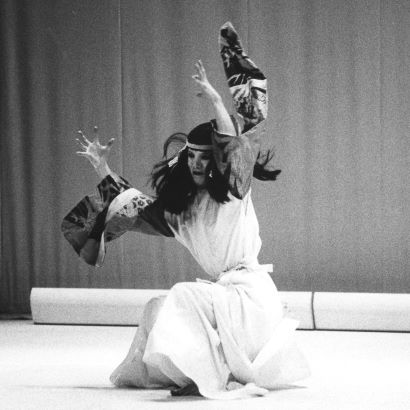
In Butoh, I became a woman, a man, an animal, and an alien. I learned that the world of the humans mind is vast and its depth is mysterious. Around this time, I saw a wonderful catch copy at a subway station, which said, “Mind seeks Form, Form forwards Mind,” which Heidegger would probably have been surprised to know. I think this Zen word explains in one word why humans are so passionate about creative activities.
舞踏の中で、私は女になり、男になり、動物になり、そして異星人になる。私は人間の心は広大であること、心の深さは神秘的であることを学んだ。そして、この頃、地下鉄の駅で「心は形をもとめ、形は心をすすめる」と書かれた、おそらく知ればハイデガーも驚いたであろう素晴らしいキャッチコピーを見た。この禅的な言葉により、人間がなぜ創造活動に情熱を注ぐのか、その理由が一言で説明されていると私は思う。
…………………………………
[1976]
[My Road / 私の道 <6>]
“Entrance / 入口”
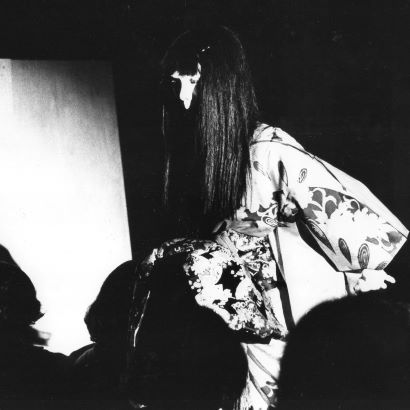
Until the time I was around 30 years old, becoming a woman in Butoh at first was a entrance to go down to the depth of the world in the mind.
私には、30才を過ぎる頃まで、舞踏の中で最初に女になることが心の世界の深みに降りていく入り口になっていた。
…………………………………
[1975]
[My Road / 私の道 <5>]
“Tear / 涙”

There was a time when I could dance if I could cry. At that time, crying was dancing to me. And the more I cried, the more sadness overflowed from the bottom of my heart, and sometimes I couldn’t tell who I was. Because I felt that it included something that wasn’t my sadness.
「泣ければ踊れる」という時期があった。その時には、私には泣くことがダンスすることだった。そして、泣けば泣くほど、心の底からいろんな悲しみが溢れ出してきて、自分が誰なのかわからなくなる時があった。そこには私の悲しみではないものも含まれている気がしたからだ。
…………………………………
[1975]
[My Road / 私の道<4>]
“Throwing Myself into Space / 空間に身を投げる”
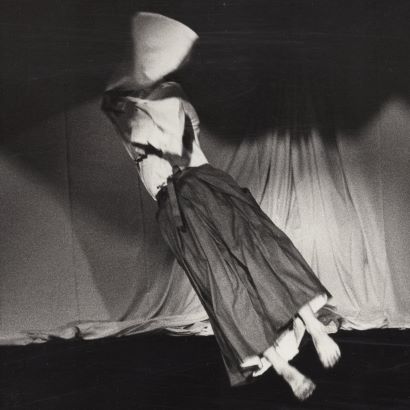
I learned a lot through Butoh. I just didn’t know until then. One of them is “throwing myself into space”. It’s more like I am moving as space, rather than putting my body in space.
私は舞踏を通して多くのことを学んだ。それまで知らなかったことばかりだ。その内の一つが、「空間に身を投げる」こと。それは、空間という対象の中に自分の身体を入れるというよりも、自分が空間になって動くという感覚だった。
…………………………………
[1975]
[My Road / 私の道 <3>]
“New Person / 新しいヒト”
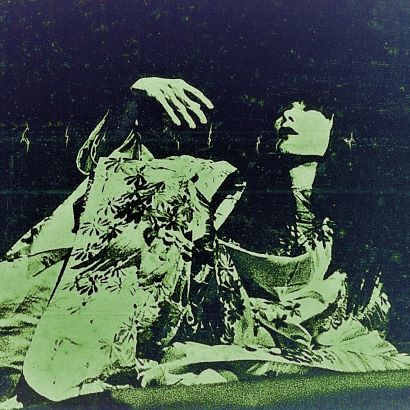
I liked Jung’s theory of Anima and Animus, so I had no opposition to the androgynous expressions that were popular in Butoh. I also learned that it is not so difficult for a man to imitate a woman’s movement by how to move the joints. And makeup. There was a member doing Japanese dance and she helped my make up. Makeup really makes people “metamorphose“. There was a “new person” in the mirror that I had never seen. This is also one of me. How interesting the world is!
ユングのアニマ・アニムスの理論が好きだったので、舞踏で流行っていた両性具有の表現にも何の抵抗もなかった。関節の動かし方で、男が女の動きを真似ることもそれほど困難ではない事も学んだ。そして、化粧。日本舞踊をやっているメンバーがいて、彼女が化粧を手伝ってくれた。化粧はまさに人を「化け」させる。鏡には見たこともない「新しいヒト」が映っていた。これも私の一つの姿なのだ。世界とは何と面白いことか。
…………………………………
[1975]
[My Road / 私の道 <2>]
“Creature that moves in a completely Unexpected Way
/ 思いがけない動きをする生物”
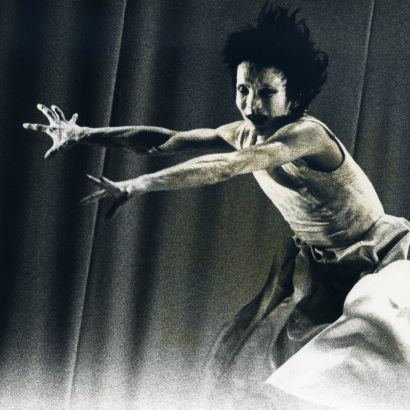
First performance. The so-called virgin recital. April 25, 1975, Asahiseimei Hall, Tokyo. I was a student in the engineering department of university and had no connection with dance, but I became a Butoh dancer. My biggest impression as a Butoh dancer was “I am a creature that moves in a completely unexpected way.” I was just surprised at my dance movements.
最初の公演。いわゆる処女リサイタル。1975年4月25日、東京・朝日生命ホール。大学の工学部の学生でダンスにはまったく縁がなかった私が、舞踏家になった。その一番の感想は、「自分がまったく思いがけない動きをする生物」だった。ひたすら自分で自分のダンスの動きに驚いていた。
…………………………………
[1973]
[My Road / 私の道 <1>]
“Power of Butoh / 舞踏の力”

My first dance photo I could keep. 23 years old at Waseda University in Tokyo. I was dancing with excitement, jumping from the second floor to the concrete ground on the first floor, but I continued my dance, I didn’t know that I had a broken toe. It was a night when I studied Butoh has such power.
残されている私の最初のダンス写真。23才、東京の早稲田大学。興奮してダンスしていて、2階から1階のコンクリートの地面に飛び降りるも、足の指を骨折したことも気づかずダンスしていた。舞踏にはそんな力があることを知った夜だった。
…………………………………
[all rights reserved copyright @ tokyo space dance]
